










04 Readers Respond 04 Editor’s Note This heat

06 Profile Vietnamese cuisine meets cra beer at Pho No. 1 Brewing Co.
07 Reader Bites Lemon cake bites at Middle East Bakery & Grocery
08 Street View Young designers bring dreamy creations to the 2024 SAIC student fashion show.

10 Brown | 2024 DNC Organizers sue to protest the DNC. 12 Populism What we can learn from the 1896 election
16 Books Artist Rashel Gordin’s illustrated book is long on humor and big statements.
18 Preview Token Theatre adds a gay romantic comedy to the Asian American canon with Zac Efron
19 Solo performance Esho Rasho’s solo show Dummy in Diaspora explores what it’s like to be queer and Middle Eastern.

20 Cover story Most of Chicago’s Spanish-language movie theaters have disappeared, but the histories and cultures that they encompassed are worth remembering.
24 Galil | Planet Earthlings Dave Roberts and Kristine Hengl’s inclusive new-wave night created queer-friendly spaces on and off the dance floor.

27 Gossip Wolf Rapper Joshua Virtue retires that persona to become Rama, Gyrate and Strapped throw stacked parties for Pride month, and more.

28 The Secret History of Chicago Music Motorhome’s fuzzy pop-rock holds up over the long haul.
CHICAGO READER | JUNE 20, 2024
30 Shows of Note Previews of concerts including Sharp Pins, Jean Deaux, Kumbia Queers, and Saami Brothers
&

35 Savage Love Too slippery when wet, Dan gives advice to a reader with a messy partner.
ON THE COVER: ILLUSTRATION FOR THE CHICAGO READER BY DAVID ALVARADO. FOR MORE OF ALVARADO’S WORK, VISIT DAVIDALVRD.WIXSITE.COM/HELLO-DAVID OR FOLLOW HIM ON INSTAGRAM @TUFFASAURUS. THANK YOU TO THE GALINDO FAMILY FOR THE PHOTOS OF APOLLO’S 2000 THAT INSPIRED THE COVER AND APPEAR WITH THE ARTICLE. COVER PULL QUOTE IN “PALACIOS PARA LA GENTE” BY DANIELLA MAZZIO, P. 20.
TO CONTACT ANY READER EMPLOYEE, EMAIL: (FIRST INITIAL)(LAST NAME) @CHICAGOREADER.COM
CEO AND PUBLISHER SOLOMON LIEBERMAN
ASSOCIATE PUBLISHER AMBER NETTLES
EDITOR IN CHIEF SALEM COLLO-JULIN
MANAGING EDITOR SHEBA WHITE
ASSISTANT MANAGING EDITOR
SAVANNAH RAY HUGUELEY
ART DIRECTOR JAMES HOSKING
PRODUCTION MANAGER KIRK WILLIAMSON
SENIOR GRAPHIC DESIGNER AMBER HUFF
THEATER & DANCE EDITOR KERRY REID
MUSIC EDITOR PHILIP MONTORO
CULTURE EDITOR: FILM, MEDIA, FOOD TARYN ALLEN
CULTURE EDITOR: ART, ARCHITECTURE, BOOKS
KERRY CARDOZA
NEWS EDITOR SHAWN MULCAHY
ASSOCIATE EDITOR & BRANDED
CONTENT SPECIALIST JAMIE LUDWIG
DIGITAL EDITOR TYRA NICOLE TRICHE
SENIOR WRITERS LEOR GALIL, DEANNA
ISAACS, BEN JORAVSKY, MIKE SULA
FEATURES WRITER KATIE PROUT
SOCIAL JUSTICE REPORTER DMB (DEBBIE-MARIE BROWN)
STAFF WRITER MICCO CAPORALE
SOCIAL MEDIA ENGAGEMENT
ASSOCIATE CHARLI RENKEN
VICE PRESIDENT OF OPERATIONS ANN SCHOLHAMER
CHIEF DEVELOPMENT OFFICER JIM STRUTHERS
VICE PRESIDENT OF PEOPLE AND CULTURE ALIA GRAHAM
DIRECTOR OF MARKETING AND STRATEGIC
COMMUNICATIONS CHASITY COOPER
MULTIMEDIA CONTENT PRODUCER SHAWNEE DAY MARKETING ASSOCIATE MAJA STACHNIK
MEMBERSHIP MANAGER MICHAEL THOMPSON GRANTS MANAGER JOEY MANDEVILLE
VICE PRESIDENT OF SALES AMY MATHENY SENIOR SALES REPRESENTATIVE LINDSAY FIGURSKI
SALES REPRESENTATIVE WILL ROGERS
DIGITAL SALES ASSOCIATE AYANA ROLLING MEDIA SALES ASSOCIATE JILLIAN MUELLER
ADVERTISING
ADS@CHICAGOREADER.COM 312-392-2970
CLASSIFIEDS: CREATE A LISTING AT CLASSIFIEDS.CHICAGOREADER.COM
DISTRIBUTION CONCERNS








distributionissues@chicagoreader.com 312-392-2970
READER INSTITUTE FOR COMMUNITY JOURNALISM, INC. CHAIRPERSON EILEEN RHODES
TREASURER REESE MARCUSSON
SECRETARY TORRENCE GARDNER
DIRECTORS MONIQUE BRINKMAN-HILL, JULIETTE BUFORD, JAMAL DEGERATTO, DANIEL DEVER, MATT DOUBLEDAY, TIMO MARTINEZ, JAKE MIKVA, ROBERT REITER, CHRISTINA CRAWFORD STEED
READER (ISSN 1096-6919) IS PUBLISHED BIWEEKLY BY THE READER INSTITUTE FOR COMMUNITY JOURNALISM 2930 S. MICHIGAN, SUITE 102 CHICAGO, IL 60616 312-392-2934, CHICAGOREADER.COM
COPYRIGHT © 2024 CHICAGO READER
PERIODICAL POSTAGE PAID AT CHICAGO, IL ALL RIGHTS RESERVED. CHICAGO READER, READER, AND REVERSED R: REGISTERED TRADEMARKS ®














































Re: “To T or not to T,” written by DMB (Debbie-Marie Brown) and published in the June 13 issue (volume 53, number 19)
Thanks so much for this. Deepest bows to DMB. It reminded me of a profile of a former beloved colleague, Elliott Franks [ed. note: readable at kqed.org]. Truly amazing grace—what once was lost, now is found. —Judy Raddue, via X
This piece doesn’t touch on by far the most important reason to get on T. It cured my seasonal depression and allowed me to go from barely passing two classes a semester to getting As and Bs in six. If you struggle with depression and/ or mood instability, it works a million times better than any antidepressant out there. I was hesitant to get on T because I was afraid of what it would do to my hairline, but now I know that’s a small price to pay for getting my life back. —Taiga El, via Instagram
Very beautiful story! I enjoyed how DMB walks us through how they felt, the research they did, finding representation, and then deciding what works best for them. Definitely an underdiscussed part of the Trans experience. I am glad the Reader covered it. —Sam Stroozas, via Instagram
Find us on socials: facebook.com/chicagoreader twitter.com/Chicago_Reader instagram.com/chicago_reader linkedin.com search chicago-reader threads.net/@chicago_reader
The Chicago Reader accepts comments and letters to the editor of less than 400 words for publication consideration. m letters@chicagoreader.com



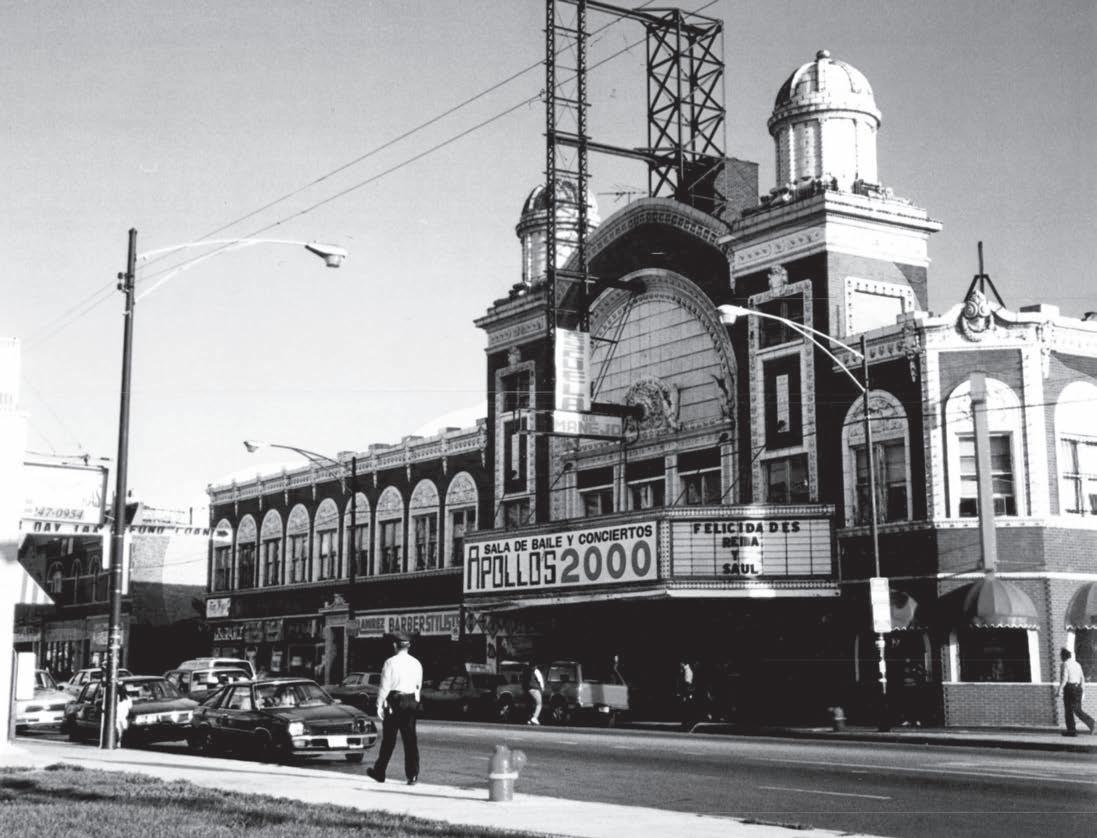
Here’s a controversial opinion: I hate summer. Heat and I are not best friends, and I struggle to fi nd slow moments during this season. Everyone and their brother is hosting a block party, a music festival plus local vendor market plus pet parade extravaganza, or a patio fundraiser. I am exhausted, overstimulated, and covered in sweat. And here’s an uncontroversial and obvious retort to everything I just wrote: I used to live for summer. One million years ago or so, I spent several summers selling grilled cheese sandwiches and my friend Stacy’s awful jewelry out of the back of a Vanagon, going from Grateful Dead show parking lot to Grateful Dead show parking lot all over the country. (In the early 90s, the waning years of Deadhead Nation, this meant sports stadium parking lots
and hearing local classic rock radio format DJs make fun of the neo hippie teenagers while queuing up “Touch of Gray” for the umpteenth time.)
Summer was my chance to get out of Dodge, live as freely as one could possibly live while traveling in a transmission-challenged van. Earlier in childhood, my family was able to send me along to YMCA-sponsored summer camps in the wilds of Wisconsin, which planted the seed of adventure and introduced me to the concept of mixtapes via our cool college-age camp counselors. These days, perimenopause and some chronic body issues prevent me from fully enjoying each and every outdoor activity. My favorite thing to do in the summer is to read in the backyard, surrounded by dogs. My second favorite thing to do is have people over to my
backyard to listen to music. But I still feel bad when I don’t or can’t make more of an e ort to tool around the city in the way I did in my 20s. Breakfast at the pre-renovation, pre-Guy Fieri visit White Palace Grill, a ride on the Roosevelt bus with bikes in tow to hit record stores in Oak Park, someone’s lawn party, someone’s birthday on a roof. All before 10 PM. Or a quick walk through Grant Park to stand next to Buckingham Fountain and breathe in water and air. There’s a lot to choose from this season if you’re trying to fill your summer dance card (or if you’re just feeling like being outside). Read on in this issue for places to escape to and embrace your version of what summer should be. v
—Salem Collo-Julin, editor in chief m scollojulin@chicagoreader.com








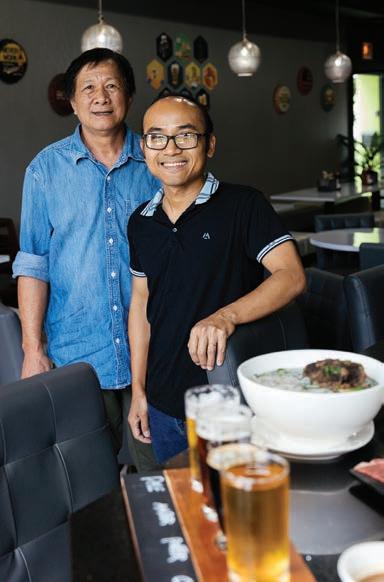
RESTAURANT PROFILE
On the far northwest side, Son Ton is concocting experimental brews inspired by the pairing of street food and bottled beer in Saigon.
By STEVEN MELENDEZWhile green-dyed light lagers flowed from taps across Chicago on Saint Patrick’s Day, Pho No. 1 Brewing Co. in Belmont Heights delivered a different take, brewing a green stout with pandan leaf and co ee.
It was a typical experimental concoction from Pho No. 1, a restaurant and brewery where owner Son Ton regularly creates new brews using ingredients more associated with Vietnamese cuisine than U.S. craft beer culture. A more recent variation on an imperial co ee stout is a direct nod to Vietnamese coffee, using the New Orleans–style Cafe Du Monde grounds found at Vietnamese restaurants across the country. A bit of milk sugar
mimics the sweet and creamy condensed milk commonly found in Vietnamese coffee, helping to o set the bitterness of the alcohol and co ee.
“The idea was, I always wanted to incorporate craft beer into Vietnamese food,” says Ton, who launched the restaurant in 2022 with his wife, Ngocanh Do. “I didn’t see a lot of that concept around.”
It was the second restaurant for the pair, who opened the first Pho No. 1 restaurant— sans brewery—in Jefferson Park in 2014. They’ve since closed that location to focus on the current spot, which occupies a distinctive bright-green building on Belmont Avenue with enough room to brew on-site. Soup, nat-
urally, still remains a staple, particularly pho made with a bone-based broth that cooks for two days before it’s ready to serve.
“We work really hard on making the broth,” says Ton. “We really never compromise on that.”
Pho fans also have their choice of cuts and styles of beef to add to the soup, including filet mignon, rib eye, top sirloin, and dry-aged beef. It’s a popular choice for diners but an item that raises a special challenge at a brewery: people don’t tend to have a lot of room for beer after a big helping of broth. A solution Ton devised is another imperial stout, high enough proof at 12.5 percent ABV that it’s served in smaller vessels. It’s also flavored with spices found
Find more one-of-a-kind Chicago food and drink content at chicagoreader.com/food.
in the pho itself, including ginger, clove, cardamom, and star anise—fitting in naturally between mouthfuls of soup.
In general, the beers at Pho No. 1 are made to pair with the food, and the food is made to pair with the beers. It’s a concept Ton says was inspired by visits to Saigon, where more relaxed liquor laws let street food stalls serve bottled beer to wash down meals and snacks. “A really popular drinking food in Vietnam is chicken wings, like fish sauce chicken wings, or just grilled beef skewers, or different kinds of grilled meats,” he says. “We try to come up with things that work well with beer.”
Those Saigon street vendors typically serve relatively mild beers, Ton says, which helped inspire Pho No. 1’s light lager and pale ale. They’re designed to accompany the restaurant’s take on those wings and skewers or Pho No. 1’s roasted quail, available cooked in butter or spicy chili oil. Also on the menu is a rotating assortment of tropical fruit beers, which have included mango and pineapple IPAs and a passion fruit ale that shares some ingredients with Pho No. 1’s passion fruit wings. The hops popular in beers today conveniently have their own fruity taste that goes well with actual produce, Ton says.
His tinkering spirit goes back to around 2010—before even the first incarnation of Pho No. 1—when Ton was studying for his doctorate in neuroscience at Loyola University. Ton, who still works as a scientist within the Veterans A airs health system, was researching the negative e ects of excessive alcohol use on the brain—an irony he readily acknowledges—but found his own consumption of craft beer limited by his student budget.
“I always wanted to incorporate craft beer into Vietnamese food. I didn’t see a lot of that concept around.”
A friend let Ton borrow some brewing equipment, and he began experimenting with novel ingredients. Many didn’t work out, but as a scientist, he naturally kept notes of interesting successes, which he gradually tries out at Pho No. 1. One possible future tap is a durian beer Ton swears retains only the mouthfeel— not the notoriously strong scent—of the fruit.




D“I think at some point my obsession with making beer was too much, and there wasn’t any space at home,” he says. “So I kind of pitched this to my wife—maybe we could do this for a restaurant. That way I could pursue my hobby and also make some money out of it.”
As of now, Pho No. 1 is at least as much of a restaurant as a brewery. Ton says a lot of business comes from food deliveries, and the menu has plenty of zero-proof drink options, including a nonalcoholic Vietnamese iced co ee and assorted fruit smoothies. It’s also so far received relatively scant media coverage, and it’s hard not to assume that it might appear in more brewery roundups and Chicago foodie TikToks if it were located in, say, Logan Square or Lakeview rather than the far northwest side, where it sits just over the city line from suburban Elmwood Park.
Still, Ton says the spot has a following of fans of both beer and Vietnamese food from the neighborhood and around Chicago. Pho No. 1 is also participating in a summer “Brew Quest” brewery pass fundraiser for the Oak Park River Forest Infant Welfare Society—the kind of event that Ton says puts it on the radar of fellow “beer nerds.”
He’s also hoping to start selling bottles or crowlers of beer in the near future, which

will both cater to home drinkers and make it easier to showcase the beer in festivals.
Meanwhile, the experiments will continue: a lemongrass-lime lager is in the works for this summer, and Ton has already started thinking about options for Saint Patrick’s Day 2025, since the green of the pandan leaf wasn’t as vivid in the dark stout as he hoped.
“Next time we’ll try something else,” he says, “like maybe matcha.” v
m letters@chicagoreader.com
on’t hate me, but it’s possible that at the time of publication, these lemon cakes might not be available at Middle East Bakery & Grocery. They’re a hidden little delicacy in a plastic clamshell, shelved among the ma’amoul, baklava, and pistachio ghraybeh along the front wall of this Andersonville standby. For reasons unknown, these lemon cakes are prone to disappearing and reappearing sporadically, which simply means that every time I see them in stock, I have to stock up. They are everything you want in a lemon dessert. I fell in love at first bite with the soft, moist sponge, made with just enough zest to cut the intense sweetness. They’re
fully coated in lemon icing, which conjures the same satisfaction as the sugary, nearwaxy coating on your favorite packaged desserts, but with a more scratch-made taste and texture. The cakes come in boxes of four, and they’re small enough that one (sometimes two) is perfectly fulfilling with a cup of co ee or after a meal.
So try your luck—stop by and grab a package. If they’re unavailable, you’ll just have to buy a different amazing sweet or savory treat from the market and try again another time. And if you ever get word that they’re gone for good? Write to me—you already know I’ll start the petition to bring them back. —TARYN ALLEN MIDDLE EAST BAKERY & GROCERY 1512 W. Foster, 773-561-2224, middleeastbakeryand grocery.com v

Reader Bites celebrates dishes, drinks, and atmospheres from the Chicagoland food scene. Have you had a recent food or drink experience that you can’t stop thinking about? Share it with us at fooddrink @chicagoreader.com.
The Reader’s weekly chef pop-up series, now at Frank and Mary’s Tavern, 2905 N. Elston, Avondale
June 24 Small batch Louisiana gumbo from Dolin’ Out @dolin_out
July 1 Pies cooked by a Disney princess, with Bad Johnny’s WoodFired Pizza & Kitchen @badjohnnysgoodtimes
July 8 The return of Laimoon @laimoon_chicago
July 15 F*€k around and find out with Fafo @fafo_chicago
Follow the chefs, @chicago_reader, and @mikesula on Instagram for weekly menu drops, ordering info, updates, and the stories behind Chicago’s most exciting foodlums.
July 22 Get back to the Greek with Meze Table @meze.table
July 29 Malaysian, with the return of Foodball O.G.s Kedai Tapao @ kedai_tapao
Head to chicagoreader.com/foodball for weekly menus and ordering info!


Art and wearability walked a fine line at SAIC’s 2024 fashion show BY
ISA GIALLORENZOFashion can be fantasy but also lives in reality. For the May event Fashion 2024: Ephemera, the School of the Art Institute of Chicago (SAIC) celebrated graduating fashion design students and their work—designs that presented perfect combinations of fantastic visions and real-world solutions.
Fourteen collections were presented in the highly anticipated annual runway show, and each was made with a healthy dose of imagination and a clear point of view. “I think every student is very unique, each with a personal approach to their vision and execution,” said Anke Loh, SAIC associate professor and Sage Foundation chair of the school’s fashion design department.
Though so many of their creations were
nothing short of dreamy, the young designers proposed ideas that could travel very well from the runway to the streets. Highlights included sailor’s knot skirts by Tristan Riggs, resonant “chandelier wear” by Gracie Norine Gelinas, repurposed crocheted accents by Lily Lee, and a dystopian kawaii and punk color explosion by Maxine Audrey.
“My work testifies that African Americans are not just participants but leaders in shaping cultural norms. We innovate, inspire, and set trends. My designs incorporate the craftsmanship of quilting, pu er techniques, screen printing, and textile design with a vivid palette of AfriCOBRA-like colors. These techniques embody a harmonious fusion of tradition and innovation,” said Audrey about her

“Mad Max” collection, a bright mix of textures, prints, and shapes that would easily populate the most stylish rave party.
Inspired by the circus and the sea, Riggs gave nautical attire new meaning while featuring gorgeous pieces made out of “shipyard materials like rope, boat cleats, and discarded ocean fishing nets and buoys, sourced from small marine handcrafters and an ocean
cleanup organization . . . showcased in each garment through a theatrical lens.” Riggs’s collection was the most indicative example of artful wearability, featuring covetable pieces in very unusual ways. Details in Riggs’s garments such as colorful coral accents, thick rope constructions, and unique yet very tasteful accessorizing made their “A Sinking Ship, the Grand Applause” collection worthy of a

standing ovation.
Lee also used repurposed materials and gave handmade techniques a high-fashion treatment. “This collection is grown from things left behind. . . . All that has been neglected can blossom beautifully again,” said Lee about the “Leftover Garden” collection. As usual, guests to the event put on a whole fashion show themselves. This year’s crowd

urban.’ I’m not a traditional dresser. I favor the more experimental couture,” he said. Fresh from being featured earlier this year in a twopage spread in the New York Times, El’Zabar stands out for his style as much as he does for his music.
Jeremy Howard, 18, was also clad in Comme des Garçons and showed how a suit and tie can look both formal and punk. “I started getting into fashion as a young teen, just wanting to express myself more. I was first into sneakers, but then slowly my interest garnered to more high fashion,” he said.
Combining high fashion and high spirits, SAIC senior lecturer in accessory design and MasterChef star Tommy Walton is always a welcome sight at the SAIC fashion shows with his sunny disposition and dazzling looks. This time he was sporting a pair of Vivienne Westwood Rocking Horse platforms, a walnut laser-etched snakeskin clutch made at SAIC, and a mannequin print suit by KidSuper Studios (a brand that has been making the coolest suits around).
proved that menswear is really having a moment. It’s o cial: there’s no need for boredom in that category anymore.
Legendary spiritual jazz percussionist Kahil El’Zabar, 70, has been proving that point for a while. El’Zabar dressed in a paperlike Maison Margiela topcoat, Comme des Garçons shirt, and Givenchy pants. The veteran musician is no stranger to high fashion. “I love the ‘exotic

Designer and artist Saumitra Chandratreya also made a statement by sporting a thrifted dress worn as a skirt, and a gloved top with a dry-pepper print he designed himself. “For my undergrad thesis show, I took inspiration from the spice market in Bangalore. When I installed my work, you could not only see and feel the fabrics but smell all the spices as well,” explained Chandratreya.
Local favorite and fashion designer Jasper Drummond opted for a not-so-basic black kilt and shirt combo—an incredibly versatile look. “It’s been a lot of fun to see how what I envision on my own body can be worn on anybody,” Drummond said.
More humble pieces also had their place at the fashionable soiree. Stephen Lin donned a New Romantic look and celebrated the six-dollar ruffled Primark blouse he paired with his Yohji Yamamoto Y-3 skirt. SAIC fashion photography student Ravi Vietro mixed a perfectly fitted yet inexpensive double-breasted suit jacket with high-end sweatpants by Japanese brand Kapital. “They balance each other out,” he said.
Vietro’s friend and SAIC fashion design sophomore August Owen Geraci-Marchand was all about finding that balance as well. “I try to do refined experimental . . . pushing boundaries while maintaining elegance and presentable fashion,” he said, unintentionally summarizing the vibe of the event. v
m letters@chicagoreader.com

Chicago officials are fighting efforts to protest Israel’s genocide at this summer’s DNC. Demonstrators say they’ll turn out no matter what.
By DMB (DEBBIE-MARIE BROWN)Tens of thousands of people are expected to gather to protest the 37,000 people killed in Israel’s U.S.–funded bombardment of Gaza. But whether those protests result in a clash between protesters and Chicago police is up to the courts to decide.
The Anti-War Committee Chicago, Chicago Alliance Against Racist and Political Repression, and Students for a Democratic Society at the University of Illinois Chicago are suing the City of Chicago and Chicago Department of Transportation (CDOT) after being denied an application to protest during the Democratic National Convention (DNC), from August 19 to 22, 2024.
In its denial letter, CDOT informed the groups that they would not be allowed to protest at the two locations they requested, Union Park and the intersection at Roosevelt and Laflin—each approximately ten minutes on foot from the United Center. Instead, CDOT said they would have to confine their protest
to an alternate route four miles away, along Columbus Avenue in Grant Park between Roosevelt and E. Jackson. The proposed alternative route is insu cient, the groups argue, because it’s three miles from the convention, and anyone passing by on DuSable Lake Shore Drive or east of Michigan Avenue couldn’t see the demonstration since that section of Columbus is lined with trees.
The lawsuit seeks to overturn the city’s decision under the First Amendment. According to the American Civil Liberties Union (ACLU), the government can impose nominal restrictions on a protest’s time, place, and manner to limit a potential disruption. But the demonstration must be permitted to take place in “sight and sound” of its intended audience.
“My clients are trying to march peacefully, in an organized fashion, and deliver the message to their audience on public property,” says Chris Williams, the attorney representing the three groups, at a June 6 press conference
after a court hearing. “And it’s a political message.”
History shows, though, that it’s not uncommon for protesters at large political gatherings to have to sue to obtain a permit to march during the event. The Coalition to March on the RNC 2024 filed suit against the City of Milwaukee on June 5, alleging that a city law preventing them from marching near the arena violates their First Amendment rights. In 2016, the ACLU of Pennsylvania sued the City of Philadelphia for refusing to issue a protest permit to the Poor People’s Economic Human Rights Campaign ahead of that year’s DNC. And in 2008, the ACLU of Colorado filed a lawsuit against the City of Denver and the U.S. Secret Service for trying to set up a separate “demonstration zone” outside the convention that was enclosed by concrete barricades, fencing, and topped with razor wire.
“I am appalled to the extent that federal authorities are willing to break and violate First Amendment rights to protect foreign interests,” says Alder Byron Sigcho-Lopez. “There’s nothing more American than the First Amendment right to make sure that we condemn atrocities and injustice when they are committed.”
Protesters are concerned about what they perceive as threatening rhetoric from Chicago police superintendent Larry Snelling. “First Amendment protection is only there if you’re not committing a crime. And you can be acting out peacefully but still [be] breaking the law,” he said at a June press conference with the Secret Service and the FBI.
Protesters and their lawyers disagree. “That’s what this case is about. It’s about a superior law, which is the First Amendment to the Constitution,” Williams counters. The First Amendment allows protesters to peacefully deliver their protest to their target audience. “And that target audience will be at the United Center, including the president [of the] United States, the vice president, [and] other Democratic Party members. They will not be on Columbus Drive.”
Protests frequently occur spontaneously and without permits; a parade permit is only necessary because the coalition wants to block off streets. A city ordinance allows CDOT to deny a parade permit application if the proposed event will interfere with tra c or if there isn’t a su cient number of on-duty police available. But critics point out the response is vague and doesn’t indicate how many cops the city thinks are needed. And
since Chicago is delaying the start of the next school year to accommodate the anticipated chaos of the convention, protesters feel city police should have su cient resources at their disposal.
The city can also deny an application if it’s “duplicative.” An application is considered duplicative if an organization submits a request to protest an event one day and wants to protest the same event on another day. It also allows the city to seek fines and jail time if two organizations seeking a parade permit on the same day have a member in common. “So if I go to an anti-war protest and I go to a pro-choice protest, am I in common? I went to both. I support both,” Williams says. “Everybody could see jail time. Everybody could see civil penalties—including me and including people who are not involved in one organization.”
Hatem Abudayyeh, cofounder and national chair of the U.S. Palestinian Community Network, says some organizations want to participate in the protest but say they’re concerned that submitting a permit application could open their membership up to arrest.
City attorneys suggested they might offer protesters an alternate route closer to the United Center at a confidential meeting on June 7, according to the Sun-Times , but nothing concrete has meterialized so far, Abudayyeh says. Judge Andrea Wood gave the city a July 10 deadline to file a brief responding to the coalition’s lawsuit and set a status hearing for June 25.
But a denied permit or a failed lawsuit will not keep thousands of protesters from descending on the convention. “We are going to march—with or without permits—because it is our right,” Abudayyeh says. He and his group fear a potential violent clash with Chicago police. “We want the permits because we know it will be the biggest, broadest, most diverse, multiethnic, multinational [coalition]. . . . For them to feel safe, we need the permits.” Abudayyeh says the coalition will pressure the mayor’s office to reconsider. He says they’ve done this sort of work—organizing, filing lawsuits, and calling mayors—for a long time and have plenty of experience. “We were the leaders of the 2012 NATO protests in Chicago. There’s going to be tens of thousands of people here, maybe as many as 100,000. It is going to be the largest protest in the history of Chicago for Palestinian rights.” v m

Are you 55 and Older Caring for a Child Under 18 or Loved One (19-59) with a Disability? Grandparents or


One-on-One Counseling: Discuss
Support Groups: Share your stories, challenges, &
By Christiana CastilloA photograph on the Crown Family’s website: a brown girl holds a handmade sign that says “stop gun violence”. Hand-drawn guns. Red prohibition signs. In Gaza, brown girls are murdered by guns, by bombs, by people, by a so-called country that is younger than the oldest tree in Chicago. In Gaza, the guns, the bombing, the shelling, the fires that set people and olive trees ablaze never cease.
Does gun prevention exclude bombs?
In Chicago, The Crown Family never ceases their ties to defense contractors, where they are the largest shareholders. The Crown Family is tied to blood, bombs that rip people of all ages to shred,
In Chicago, my brown body walks past tall buildings named after the Family. In Gaza, brown bodies walk past dead brown bodies, past demolished buildings, courtesy of the Family.
What does it mean when a Family is responsible for funding the bombs that end entire family bloodlines?
What does it mean to dedicate money and time to repair the world, if you only set it ablaze?
When will the bombs stop?
I ask the Crown Family, how much blood is enough? There’s more running blood than water in Gaza. How many art projects will you fund this year?
Christiana Castillo (she/her/ella) is a poet gardener, cultural worker, and educator.
Poem curated by Bindu Poroori (@himabindu). Bindu wishes for the annihilation of class, caste, and race. They are Interim Director of Community Organizing at Arts Alliance Illinois, an organizing member of @chicagodesiyouthrising (CDYR), an organizer with UChicago Alumni for Palestine (@uchialum4palestine), and part of the surf punkBollywood cover band, Do The Needful (@dtn_chicago). She would love to talk to you about green mango dal.
Summer Hours
Wednesday– Saturday: 11:00 AM–5:00 PM
Poetry on Stage: Sarah Ruhl’s Letters from Max
Join us for a reading of Sarah Ruhl’s play, Letters from Max, directed by Polly Noonan. This play shares letters and poems passed between Ruhl and her former student, poet Max Ritvo, as he candidly discusses terminal illness and tests poetry’s capacity to put to words what otherwise feels ineffable. Sarah Ruhl will play herself and Zane Pais will read the role of Max Ritvo. A brief talkback with the playwright will follow the program.
Saturday, June 29 at 2:00 PM CT
Exhibition Opening: A Bigger Table: 50 Years of the Chicago Poetry Center
In celebration of the 50th anniversary of the Chicago Poetry Center (CPC), this event features a film screening, live performances, and an exhibition of historic broadsides, event posters, and treasures from the CPC archive.
Saturday, July 13 at 2:00 PM CT
Learn more at PoetryFoundation.org




What the 1896 election can teach us about 2024
By MICHAEL SPENCERThis is the first piece in a series about three nominating conventions in Chicago that changed the course of United States history.
As Donald Trump’s legal troubles closed in around him this spring, the embattled former president and some of his supporters compared their suffering to none other than Jesus Christ. They marked the Easter holiday with parallels between Trump’s sprawling legal defense and the biblical persecution of the messiah. Last month, after his conviction for 34 felony counts related to falsified business records, people flooded social media with sincere and ironic reposts of Trump crucified beneath McDonald’s great golden arches. These allusions aren’t new. Late last year,
a pro-Trump media outlet produced a video ri ng on Paul Harvey’s 1978 speech, “So God Made a Farmer,” suggesting God created Trump to save the United States from “Marxists” and “the deep state.” Trump shared the video on his social media platform, Truth Social, and eagerly screened it at rallies. And two years ago, a nearly life-size painting of a MAGA crucifixion made the rounds online. It depicts the former first lady, Melania Trump, kneeling at the cross as then House speaker Nancy Pelosi drives a spear into Trump’s side. That particular image of a crucified populist leader is familiar. While 128 years have passed since Chicago hosted the 1896 Democratic National Convention, the silhouette of a populist leader—arms stretched wide on a golden cross—is a time-honored classic and historic piece of Americana.
The period between the Civil War and the 1896 Democratic National Convention (DNC) is famously neglected in U.S. history classes. As the government negotiated the return of southern states to the Union and the challenges of Reconstruction, major problems needed to be solved at the federal level.
But the most important part of this story is at the state level. As sectional tensions grew in the mid-1800s, territories took longer to become states. The process, which lasted 12 years before 1848, now took nearly twice as long amid wider government debates over chattel slavery and state sovereignty in the U.S. A backlog of aspiring territories grew during these years, from Minnesota to the Dakota Territory.
This meant the political field in some western states matured for up to a quarter century before local competition for political power translated into power on the state and national stages. Most major political issues on the frontier concerned land boundaries; more specifically, the division of economic resources and the apportionment of political power to those who controlled them.
Political identity in the west became an
expression of a person’s opinion on how the state should solve economic problems. These identities were constructed by people dislocated—literally and figuratively—from the base of political power in the east. It was in this context, where a person’s primary relationship with the state was as a vehicle for improving their economic situation, that the populist movement developed. From Texas to North Dakota, an alliance of farmers sprang up, demanding a raft of political reforms to ease the economic challenges of an industrializing agriculture sector.
Populism is a political style more than an ideology, and it happens when a member of the political class positions themselves in opposition to mainstream political elites. It doesn’t matter whether that person is a sitting U.S. senator or a world-famous real estate investor; populist leaders often lead unusual lives. Regardless of identity or ideology, what defines the populist style is the vilification of culpable elites in front of the righteous masses, attempting to shift power away from traditional places. In the U.S., power was traditionally concentrated in the east. The act of state formation and westward expansion was, fundamentally, an act of transitioning power elsewhere.
For around two decades before the 1896 election, industrial agriculture’s boom-andbust cycle impacted Americans’ everyday lives. Small-scale farmers learned that wealth generated by their farms didn’t flow down to them. But the founders’ vision of democracy rested on the shoulders of these farmers, who gained access to full citizenship and voting rights through land ownership. This vision failed to anticipate the pace of change in the 19th century and the realities of industrialization.
Teaching this period of U.S. history (and remembering it from history class) is challenging because the most coherent political issue of the time is not one we’re familiar with today. The populist economic reforms we recognize include income taxes, the Federal Reserve, bank regulation, and anti-monopoly laws. The movement helped introduce ballot initiatives, referenda, and the direct election of senators. But the initial focal point for the populist intervention wasn’t any of these things. Instead, to understand this history, we have to wade into an issue that is genuinely Gilded Age ephemera: bimetallic monetary policy.
Before the Civil War, the U.S. included silver
and gold in its monetary standard at a 16-to-1 ratio. The federal government printed fiat currency during the war to keep the northern economy churning. For the first time since the struggle for independence from Britain, the U.S. was printing its own money without the backing of precious metals. After the war, policymakers shrunk the money supply drastically, eliminating silver and putting the U.S. on the gold standard.
“Here was a political messiah who was to lift the burdens that the oppressed had borne for so long.”
In our modern world of fiat currency, we’re used to discussing inflation, which the Federal Reserve tries to keep around 2 percent annually. But when the U.S. returned to the gold standard, the value of the dollar increased dramatically, causing the currency to deflate. This was a problem felt especially acutely by small landholders in the west and predominantly Black tenant farmers in the south, who had to borrow against their crop just to start planting and hope their harvest
was enough to cover the loan at the end of the season. Often, it wasn’t, which meant producers found themselves working the next spring to pay back what they’d lost the previous fall. A shrinking money supply intensified this bind as the value of debts increased while prices at the market fell.
To fix these problems, populists on the frontier rallied behind “Free Silver.” The reintroduction of silver, they argued, would inflate the money supply, decrease the relative value of their debt, and increase the cost of their produce at the market. The fix was simple and became the most salient issue among many Democrats and Republicans outside the northeast.
Workers in Chicago were fighting their own battles with the forces of industrialization. In spring 1894, Eugene V. Debs led the American Railway Union (ARU) against George Pullman’s luxury train car factory on the south side. After the initial strike failed, the ARU launched a national boycott of any train with Pullman cars, grinding the national railway system to a halt.

Debs and the ARU rallied on June 29 to support striking Blue Island workers. Things spiraled out of control as workers razed surrounding buildings and derailed a train carrying a U.S. mail car.
Seeing an opening for federal action, President Grover Cleveland ordered 15,000 troops and agents into the city. Illinois governor John Peter Altgeld was outraged. He thought Cleveland, a fellow Democrat, had overstepped his executive authority by deploying the military for a matter that could’ve been handled by local police.
The political situation was a tinderbox in the 1890s. Anxieties about the closing western frontier, intensified labor disputes, and a collapsing global wheat market increased tensions in cities and the countryside. A populist movement simmered underneath the surface. Up to this point, Democrats struggled to fully absorb the Free Silver populists
on the frontier, who seemed likely to make a third-party challenge in the run-up to the 1896 election if they failed to get the party’s nomination. But in Chicago, the silver wing of the party linked up with Illinois Democrats who wanted to see a changing of the guard.
As many as eight candidates arrived in Chicago for the 1896 DNC hoping they’d be the one to secure the party’s presidential nomination. Among them was William Jennings Bryan. Born on March 19, 1860, in Salem, Illinois, Bryan attended law school in Chicago. He and his wife, Mary, moved to
rapidly growing Lincoln, Nebraska, in 1887. He started a law practice there and served for two terms in the U.S. House of Representatives. After leaving Washington in 1894, Bryan found his way to a lucrative spot on the public speaking circuit, where he honed his pro-silver message and populist rhetoric.
In June 1896, Republicans gathered in Saint Louis, where the party nominated Ohio governor William McKinley on a pro-gold platform. The Grand Old Party (GOP) sided with the “sound money” economics that favored its base among the monied interests of the northeast. With the GOP going for gold, the focus for



continued from p. 13
Democrats became who would hold up the banner for silver. Pro-silver delegates held a simple majority—enough to control the platform but short of the two-thirds margin required to nominate their preferred candidate. And anyway, silver Democrats lacked organization in the year leading up to the convention, actively eschewing e orts to unite behind one person.
Richard “Silver Dick” Bland of Missouri, widely considered the party’s front-runner, even lost support at the state conventions for too openly courting the nomination.
Bryan, on the other hand, avoided the folly of Bland’s eagerness and endeared himself to Free Silver Democrats by putting the monetary issue ahead of personal ambitions. He was determined not to be seen courting delegates. But privately, he was convinced he should be the Democrats’ nominee. Unlike other presidential hopefuls, Bryan didn’t have a campaign o ce in Chicago. In late June, he told reporters he wasn’t even in the race, and he left the Windy City to return home to Nebraska for a speaking engagement. His candidacy was barely mentioned in the newspapers. As Bryan returned for the convention, pro-silver Democrats lined the streets to see Bland and his marching band.
a second term that saw the end of Gilded Age economic growth. As global grain prices plummeted, investors began withdrawing gold from the U.S. treasury. Financier J.P. Morgan called a meeting with the president. With the prospect of default looming, Cleveland agreed to let Morgan and the Rothschild family bail out the U.S. government, replenishing the gold supply by selling public bonds. This outraged Free Silver populists, whose legitimate grievances were dissoluble with their nativist xenophobia.

As delegates flocked to Chicago in the summer of 1896, party leaders like Governor Altgeld agreed the Democrats couldn’t nominate Cleveland for an unprecedented third term. But they couldn’t agree on his replacement. By the second day of the convention, with the Democrats no closer to nominating a candidate, Bryan called his shot as he sat with his future biographer, Charles Rosser, at dinner that night. He told the table that he was the only possible Democratic nominee. “I am what they call ‘the logic of the situation.’”
The next day, Bryan stood before the throngs gathered in the Coliseum. Even

It’s fitting that the 1896 Democratic National Convention took place in the second Chicago Coliseum. The indoor convention center was completed in May, just before the DNC opened on July 7. The Coliseum was massive for its day; at twice the size of Madison Square Garden, as many as 25,000 people could fit inside. By December of the following year, the building would be gone, burned to the ground in 20 minutes after some electrical wiring caught fire. But, before it rose in flames and disappeared almost as quickly as it came, the second Coliseum hosted a pivotal scene in U.S. history.
Like its venue, the DNC had to span a monumental chasm, providing a platform and a candidate to hold the party together under one roof. Cleveland was coming to the end of
Even in failure, the populist movement and the 1896 DNC left a significant mark on U.S. history.
justifying the pro-silver platform, not to become its presidential candidate. As he spoke, he wove together images of toiling masses and comfortable elites. He decried the top-down economic policies favored by Cleveland and the Republicans, who said prosperity would “leak through on those below.” Those who labored, he said, should be given the same consideration by U.S. policymakers as those who owned capital.
In the final moments of his now famous “Cross of Gold” speech, Bryan evoked the crucifixion of Christ. “You shall not press down upon the brow of labor this crown of thorns,” he declared, placing his hands on his temples. “You shall not crucify mankind upon a cross of gold.” He stood on the stage, his arms stretched wide.
For a moment, the Coliseum fell silent. Bryan paused as the room realized what he’d known for some time: he was the Democrats’ 1896 nominee. And then, as he worked his way o stage, pandemonium ensued. The prosilver delegates demonstrated on the convention hall floor for nearly half an hour, parading Bryan around the arena.
Sitting next to Altgeld that night was none other than famed labor and defense attorney








would defend a teacher’s right to edify students with the theory of evolution. “Here was a political messiah who was to lift the burdens that the oppressed had borne for so long,” Darrow recalled in his autobiography of Bryan’s rise to power. Bryan had transferred Free Silver’s principled populism, which for so long avoided association with any individual, to himself and to the Democrats’ ticket through the imagery of Christ crucified.
Altgeld leaned over to Darrow and admitted it was the greatest speech he’d ever heard. Then he asked, “What did he say, anyhow?”


TThe second Coliseum, in the Woodlawn neighborhood, was twice the size of Madison Square Garden. It burned to the ground in December 1897. LIBRARY OF CONGRESS
as Bryan waited for quiet and calm, he still wasn’t considered a realistic contender for the nomination. He was there to deliver a speech
Clarence Darrow. Thirty years later, he’d sit opposite Bryan in a Tennessee courtroom, as an attorney in the Scopes trial, where Darrow
he William Jennings Bryan presidential campaign was a disaster for the Democrats. Bryan campaigned hard in the midwest, while McKinley ran a more traditional campaign from his front porch in Ohio. With Democrats split on the silver issue, the Republicans carried the general election by more than four points. McKinley even delivered Bryan a blistering defeat in Nebraska, where Bryan had twice been elected to Congress. Even in failure, the populist movement and the 1896 DNC left a significant mark on U.S. history. While the silver issue lacks salience to modern readers, the populist economic reform package became the focus of U.S. politics after the McKinley administration. Interstate commerce regulations, the Federal Reserve System, increased access to credit, anti-monopoly policies, and the federal income tax were all in place before the end of the first World War; all were major causes of the populists. Progressives reformed the democratic process, enabling ballot initiatives and the direct election of senators. But the election of 1896 also started a long decline in voter participation. Political parties have never again had the power to galvanize the electorate as they did under this system. New political parties, which repeatedly rose to take power

away from existing institutions in the 19th century, have been electorally irrelevant for more than a century.
Populist sentiment today is usually associated with the Great Recession, which brought into focus widening economic disparities in the country. The experience led to the Occupy movements, the Tea Party, and the presidential campaigns of Bernie Sanders and Donald Trump. Just as it did after the Civil War, populism has found purchase among progressives and conservatives alike.

Social scientists who study populist politics tend to disagree about the origin of populist sentiments. Is populism a reaction to material conditions? Or is it the result of anxiety about status and other psychological phenomena? Populism is what happens when a critical mass of people decide that institu-
tional and political solutions to their problems are being blocked by the structure of traditional power. And that may be the most important thread from 1896. But perhaps there’s another through line to consider this summer when populism and presidential politics close in on the city yet again—a thread of righteous zeal running from Bryan’s thorny crown to Trump’s golden arches, connecting some Americans with a deeply held sense that their political battles are messianic and their persecution biblical. v
m letters@chicagoreader.com






For artist Rashel Gordin, public fascination with Dick-tation the male-dominated society around her.
By SONAL SONIWhen she is not behind the bar, Rashel Gordin is a mother, an artist, and an author of Dick-tation—an illustration and coloring book composed of penis drawings gathered from coworkers and patrons over the years.
Gordin studied photography and art history at the School of the Art Institute of Chicago. Despite her creative background, she didn’t anticipate becoming an author, let alone conceptualizing a book of penis drawings. Her coworker at the Dark Horse bar began leaving Gordin notes on scrap paper, always featuring phallic imagery. The two worked
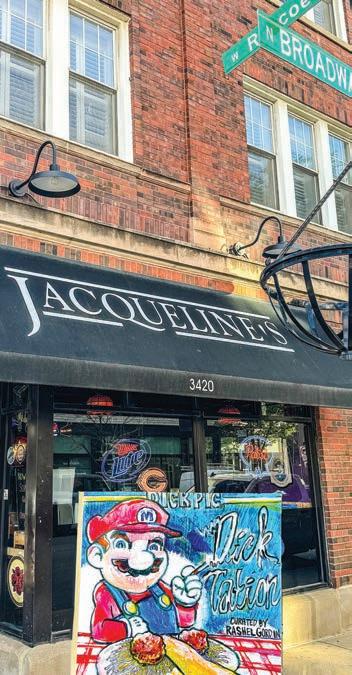
opposite schedules and typically missed each other. Those words of encouragement alongside the creative dick depictions gave Gordin something to look forward to at the start of her shifts.
“So I started after a while just collecting all of these notes . . . and then I started branching out.”
Drawings range from simplistic outlines to abstract conceptions like a Chicago-style hotdog. That illustration includes a penis on a poppy seed bun with classic toppings like tomato wedges and sport peppers. Another is of a snake-shaped penis, complete with eyes and a split tongue. An accompanying message reads: “Here is a snake cock. Have a great shift!”
Illustrations from bar patrons appearing in Dick-tation

Gordin compiled those drawings into a book in 2019. The Dark Horse closed down during the pandemic, and Dick-tation found its new home at Jacqueline’s bar on Broadway. News of the book spread through word of mouth, and since then, folks from around the city have flocked to Jacqueline’s to flip through its pages and contribute their illustrations.
Emory Murphy works with Gordin and has contributed numerous original drawings. He began drawing penises as early as elementary school; according to Murphy, anyone can draw one.
artists like Cynthia “Plaster Caster” Albritton, Gordin’s work uses phallic imagery to spark conversations about the gender binary, double standards, and sex positivity.
“People thought it was really funny, but for me, it made a bigger statement,” Gordin said.
“I remember learning how to draw a dick in like the sixth grade. I can’t even remember when someone taught me how to draw a vagina.”
“It takes creativity but not necessarily talent and that’s so fun. This is just a thing we would do to make each other laugh at work.”
The depictions offer a lighthearted re-
The book left Gordin wondering why certain body parts like penises are considered more acceptable to discuss; in comparison, the topic of vaginas felt like a taboo subject. She also began to reflect on her experiences and observations about how people view women’s bodies. In Gordin’s experience, the lack of comprehensive sex education in public schools contributes to the lack of knowledge about female anatomy. While many states across the nation mandate some form of sex education, only 18 of those require that the curriculum be medically accurate.
Find Dick-tation at Jacqueline’s bar N. Broadway, 773 - 404 - 5149
works in different directions, being light and funny while having the potential to highlight something deeper.
At first sight, Chicago comedian Rogue Schmidt initially thought the book was hilarious. They subsequently echoed Gordin’s contemplations.
“I remember learning how to draw a dick in like sixth grade,” Schmidt said. “I can’t even remember when someone taught me how to draw a vagina. . . . Vaginas are secretive and not really talked about, especially growing up in rural Illinois where the sexual education system isn’t too great.”
“[Vaginas are] kind of deemed sexual automatically, where dicks are viewed as punch lines,” Schmidt added. “The taboo with it is
Gordin plans to publish Dick-tation . For now, the original copy lives at Jacqueline’s, sparking laughs and varied conversations. Although that book is complete, folks can still contribute phallic illustrations for her ongoing projects of images solely drawn at the bar. Gordin is working on books titled Cock-Aand The Second Cumming. Like
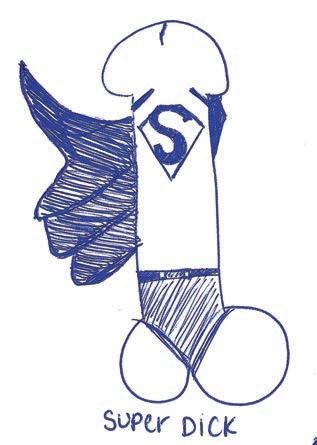
Dick-tation, they also serve as artistic avenues for Gordin to fuse her bartending career with her love for art.
“Anything goes in bars,” Gordin said. “Inhibitions fly out the window and I get the raw, the nitty-gritty from people around me. People love seeing their works in a book form. It’s awesome.” v
m letters@chicagoreader.com










6/20 -7/21: Thu-Sat 7 PM, Sun 3 PM; also Wed 6/26 7 PM (celebration of Gay Pride Chicago) and Mon 7/17 PM (industry), no performances Sun 6/30 or Thu 7/4; A Red Orchid Theatre, 1531 N. Wells, tokentheatre.net, $ 40 (industry/seniors $25, students/military $20)
Openly stating, “No fats, femmes, or Asians” (“no FFA” for short, and sometimes the more expansively exclusionary “No Asians, no Blacks”) was not so long ago no big deal—prevalent enough on dating apps to make it the primary example cited by Zach Sta ord, former chief content o cer at Grindr, of the kind of “discriminatory language” that was o cially banned from the app as of September 19, 2018. The phrase was justified as a statement of the dater’s preference rather than his racism, fatphobia, and misogyny. “It reconstructs the Asian identity as a ‘type,’ allowing this ‘preference’ to be interchangeable with one’s racial and ethnic identity,” theorized one author in Sparks Magazine. Yet beyond the individuals who said it, perhaps more deplorable is the community that accepted it. “Why is white the primary color of gay male beauty?” asked Jimmy Nguyen in the Advocate in 2011. Noting that the bars, parties, and gyms of elite gay culture are predominantly white, Nguyen describes the unique irony of being a racial minority within a historically oppressed minority community that nevertheless upholds white supremacy. “In part, that’s because racial minority groups still are not fully integrated into the queer sphere. It’s also because power in America (gay or straight) has historically been concentrated in white hands. But mostly, it’s because the men considered most attractive, by the most people in our country, are ‘all-American’ white,” he writes, admitting, “The irony for me is that I’m one of those gaysians mainly attracted to white men.”
In a culture that stereotypes Asians as passive and submissive—the antithesis to ideals of whiteness, wealth, and heroic muscularity—what’s a gaysian to do to find love? And what happens when the thing that you obsess over looks nothing like you? “Growing up in the 80s, when I went out to the bar with my Caucasian friends, I kind of disappeared. I didn’t really exist for other people at the bar
because that’s not what they were looking for,” says Alan Muraoka, Sesame Street actor and Emmy Award–winning director of Token Theatre’s first full-length live production, premiering this week at A Red Orchid Theatre. Forty years later, David and Wai, two gay Asian men in their 40s stymied by racism, the pandemic, and the mundane woes of modern life and dating apps, are still struggling in David Rhee’s play Zac Efron , cowritten by Wai Yim. David (Hansel Tan) wants two kids, a white picket fence, and a husband who looks like Troy Bolton (Efron’s character in High School Musical). Wai (Yim) is a YouTube influencer who reads tarot online to legions of horny horoscope enthusiasts. A contemporary
gaysian Bert and Ernie, their bickering and bantering is the crux of a play that makes light of a demographic as specific as astrologically obsessed queens with an online German housewife following, and as broad as second-generation Americans desperate to fit in with their peers and win the approval of their immigrant parents. They’re just two guys looking for love in an onerous world. Zac Efron could not be more di erent than what Rhee originally envisioned for Token Theatre’s debut production: an all-Asian edition of Thornton Wilder’s Our Town . “Asian Americans kept on being told we’re not part of this town, we’re not part of this country, so my idea was to cast East Asian and South Asian people and have them dress up initially

actors in Chicago were furious—we’re right here!” Rhee recalls. “This isn’t considered our town—so I’m going to do the most traditional American play as pansori, where the only thing accompanying it is a drum, and this person is almost screaming the lines to say, ‘This is our town.’”
“If you look at most of my plays, they always end in what Aristotle calls a ‘scene of su ering’—Aristotle believed that every play has to have some sort of scene of suffering, whether it’s someone’s hand being cut o , i.e., The Empire Strikes Back, or death,” says Rhee, a Broadway veteran who teaches English literature at Phillips Exeter Academy. “This time we decided to go the opposite of every instinct that we had. Believe it or not, [Zac Efron] was a tragedy initially.”
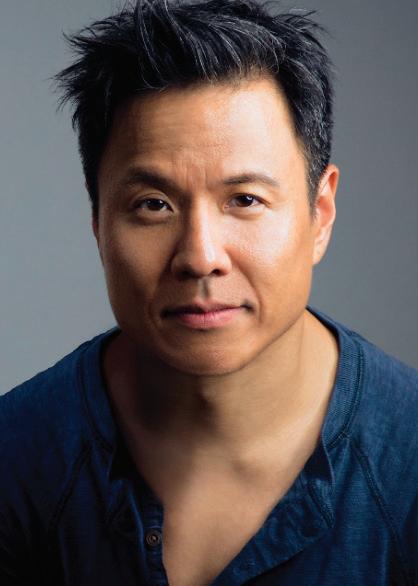
in their traditional cultural clothing. As they become more Americanized, little bits and pieces of their costumes start getting ripped off, and you see them wearing jeans underneath. It ends in death, and I wanted that to be a parallel to the death of their culture,” he says.
The concept stemmed from a 2006 Time Out Chicago article on the whiteness of Chicago theater that quoted one casting director saying that no Asian actors from Chicago could be found for a recent production. “The Asian
Encouraged by a friend to find the happy ending rarely granted in mainstream “Asian” narratives ( Miss Saigon : suicide. The King and I: death), Rhee saw and chose to celebrate the beauty of his collaborator. “Wai is such a fantastic actor. I have worked with him. I have seen him and the roles he would get. You see what he looks like—he’s a very specific type, and people were not giving him a chance. Plus he has that accent [Yim is from Hong Kong]. So there’s this one line, ‘What about me? Tall, lanky, with a chinky accent. Do you know how many roles I’m right for?’ and he says, ‘All. Of. Them.’”
“What drew me was the humor,” says Muraoka, who directed two online productions of Zac Efron for Token. “In the canon of Asian American plays, there’s not many comedies— there’s even fewer gay comedies, and gay romantic comedies basically don’t exist.”
“We don’t have gay Asian plays that feature two Asian men without any special circumstances—it’s not the Cultural Revolution or the Vietnam War,” adds Yim. “Do future generations have to keep doing Miss Saigon and The King and I? There are only like five plays that people do, and they’re always about family trauma.”
“Tragedies can be funny, too,” says Rhee. “I mean, look at Chekhov.” v
m letters@chicagoreader.com
DUMMY IN DIASPORA
6/21-6/23 : Fri-Sat 8 PM, Sun 7 PM; Den Theatre, 1331 N. Milwaukee, 773697- 3830, thedentheatre.com, $20.75
Esho Rasho’s show draws on his own coming-of-age experiences.
By YASMIN ZACARIA MIKHAIELDummy in Diaspora, like life, doesn’t present complete answers. The new solo play, written and performed by Esho Rasho, features a queer Middle Eastern coming-of-age story. Rasho, the Chicago-based actor and writer, wrote the one-person show in a fervor over three days in January as he navigated the uncertainties of postgrad life, the cancer diagnosis of a parent, and the strife of surviving as an artist under capitalism. The semi-autobiographical play has had a somewhat unprecedented timeline to production, as Rasho was convinced by friends to submit it to companies around town. An improv theater replied the day after he submitted with deep interest and a question: could he get it on its feet in three weeks? Now it’s appearing this weekend at the Den prior to a run later this summer at the Edinburgh Festival Fringe.
Yasmin Zacaria Mikhaiel: I can’t recall how I came across Dummy in Diaspora , but I clocked the Persian rug and chai in your marketing photos and was immediately pulled in, as I’m a part of the SWANA/Middle Eastern diaspora as well. Can you tell me about your roots in and beyond Chicago?
Esho Rasho: I’ve known the city my whole life. Even when we didn’t live in the city, I’d spend a lot of time in the city. There is a large Assyrian community in Chicago, where I’d spend time

with my mom’s friends and my cousins. I’m the youngest of five siblings in an immigrant family, and being an artist was a big choice.
I’m curious to hear what drew you to the arts and making things.
It was stories. I’ve always been drawn to stories. When I saw a production of The Wizard of Oz when I was five, there was something magical about witnessing a story about a place that wasn’t in the room we were in. I just knew I wanted to be a part of it. When I was ten, I searched up a children’s theater, and was like, “Mama, baba, please can I do this?” And they were confused but like, “OK?”
They just kind of would take me to rehearsals, and they didn’t really know what I was doing, but they just trusted it.
It can feel like such a gamble for us first-gen/ second-gen artists to commit to the arts. I know my parents were also skeptical of that career path for me. But they still showed up.
Yeah, they were at every single one of my shows. My dad has not understood any one of my shows, but they still come and support me, and that’s really important to me.
I fell in love with stories and that love has evolved beyond college. I’m a storyteller at heart. I can’t not be. One of my favorite art-
ists, Lorde, has this quote where she says she started seeing [her] life as art before [she] had any success. And I was like, oh my god. I feel like, especially in my adolescent years, I was witnessing my life like it was an art piece. It’s kind of cringey to say, but I think that’s how Dummy in Diaspora came about.
You’ve called this an autobiographical work, pulling from your own experiences growing up as a queer Middle Eastern kid. Can you tell me more about the desire to share these personal stories?
My parents are Middle Eastern Christians and so they used religion as a coping mechanism throughout their lives. They sort of pushed that on to me and my siblings growing up. But this led to absurd experiences growing up here in the U.S. [with] my unique identity.
Since the beginning of my acting training, I was really, really horrified and had this anxiety about what roles there would be for me. I knew I never wanted to play a terrorist role. I was really scared of the roles that I would get because I did not believe I could play a full, authentic human—being the way that I look, with this name, and the assumptions that come with me as an artist.
Dummy in Diaspora is my way of [centering] a full, authentic, real person in the identities that I [inhabit] in my everyday life on stage, and an attempt to not feel misunderstood.
The desire to be understood shows up in the core of this piece. Some of your stories center learning English as a second language and your initial struggles with it.
Yeah, I was gonna fail kindergarten because my English hadn’t progressed that year, and my mom fought the principal. She was like, “I know my son, he’s gonna do fine.” She fought so hard. My mom’s the first person in her entire family to go to college, so her English is better than her family’s, even if not the best. But she knows how to make her English good enough to tackle the American mind, and so I didn’t repeat kindergarten. But I did have to be in English [as a] Second Language classes up until I was in fifth grade.
I wonder how you see this solo play fitting in and beyond diaspora narratives.
What really struck me, or I guess surprised me, from previews was that people from completely di erent backgrounds than me said, “Oh, I saw myself in that.”
That’s exactly what I wanted to do as a writer, but I didn’t think that would be possible with the show because it’s such a specific story. But what I’m learning is that the most specifi c stories are the most universal also. There are parts of the story that are just human. There’s a human being looking for themselves, a human being trying to survive, a human being coping, a human being having fears—especially fears of aging, his body changing and fading. And then, there’s a part where he doesn’t want to be Christian anymore. That’s very much a Middle Eastern diaspora narrative. It’s specific, it’s cultural, but it’s also universal.
There’s a certain feeling of incompleteness here, too. The character Essa is maybe searching for answers about his identity and his future.
In life we never get complete answers, right? We’re not always going to get the answer that we want. Or, there’s a lot of unknown That’s what I’m looking for. There’s a lot of unknowns in life. And I think this show presents Essa’s unknowns, and then you don’t necessarily get to hear some completes, the solutions.
I think the story’s really bigger than me. People were like, “You’re so funny, you’re so funny. You love this type of drama stu but you make people laugh.” That’s fine, but what I want to do with my work is move people. I’m obsessed with honesty. I’m obsessed with raw truth. When I go into a theater—if I’m gonna leave my house to go to a theater instead of watching a TV show—I love seeing raw, ugly truth. I don’t try to make my writing pretty. I don’t try to be pretty on stage in the sense of, like, you know, like emotionally.
Humans are imperfect. Humans do bad things. Sometimes humans can hurt people, and sometimes even hurt themselves. And those are the types of stories that I love. And I think Dummy in Diaspora is kind of an ugly story because I think I pulled o some inhibitions and wrote some truths that I was really scared to write. v
m letters@chicagoreader.com
Most of Chicago’s dedicated Spanish-language movie theaters have disappeared, but the histories and cultures that they encompassed are worth remembering.
By DANIELLA MAZZIOOn a Thursday in March 1968, eightyear-old Javier Galindo and his family arrived for the first time in the United States after emigrating from Mexico. Three days later, they sat at the Marshall Square Theater at 2875 W. Cermak and watched a black-and-white cowboy movie in Spanish.
“This was the place to come on Sundays,” Galindo remembers. “You’d go to church, and then you’d come to the movies, that was it.”
Galindo’s early memory of the theater would become the symbol of his American dream. In 1988, Javier and his wife, Lidia, purchased the theater, which they renovated

the following year and have operated as the event space Apollo’s 2000 ever since. On April 17, 2024, Apollo’s 2000 was designated as an
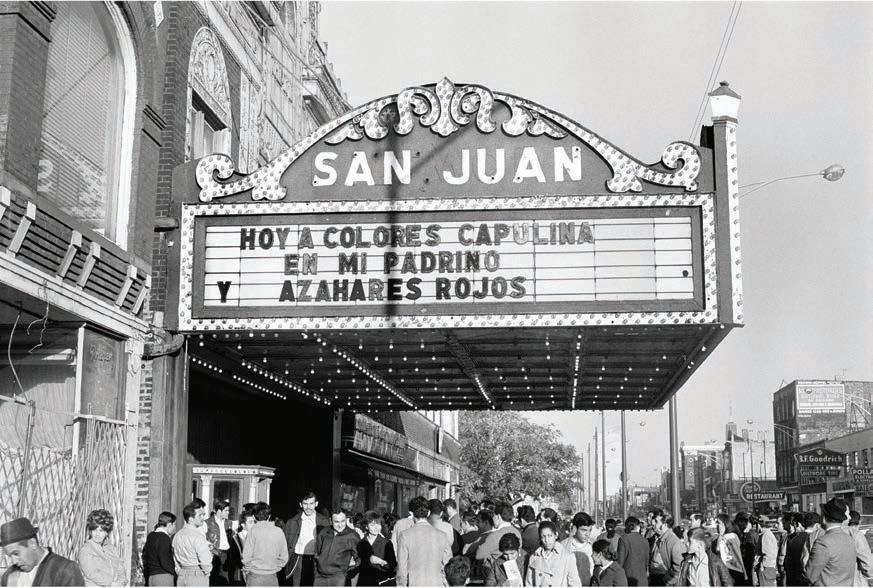
o cial landmark by Chicago’s city council. “You would never dream that one day I would be the owner or steward,” Galindo says, beaming with nostalgia as warm as the former movie palace’s gold-painted trim, which the Galindos and their daughters Isis, Naomi, and Evelyn Stell have worked so hard to preserve.
When I interviewed Galindo in the spring about the Marshall Square Theater and other Spanish-language movie theaters in Chicago, he focused heavily on the memories made at the venue across the decades, for his own family and countless other Spanish-speaking people. “Your grandparents might have been here, once,” he says to me, addressing family history that I had shared shortly before our interview.
I wish I had a more definitive response to that
suggestion, but truthfully, I’ve only just begun to learn about my own family’s roots in Chicago. My maternal grandfather and late paternal grandmother are both Mexican and grew up first-generation in Chicago in the 1930s and ’40s. They had moved to the suburbs by the time my parents were born, but I joke that I couldn’t keep away from the city. And here I am, third generation, researching the eras and neighborhoods my grandparents lived in, exploring the places in which they may have found familiar language and community, such as movie theaters. For all that I know about the landmarks of my family and this city’s history, I realize how much there is to learn—and how much has been lost—about the actual people who walked here, who continue to walk here, and who are arriving for the first time. While former movie palaces have often been the center of architectural preservation efforts in Chicago, initiatives to preserve the memories that occupy the theaters are scarcer, as the interests of development often focus on looking forward.
There are many ways to explore personal and global histories, but there is much we can learn about day-to-day life from the history of cultural spaces as once ubiquitous as movie theaters. Chicago’s history of Spanish-language theaters, specifically, is largely unexplored. To discover and preserve those memories is to preserve the cultural history of Chicago’s Spanish-speaking population overall.
Chicago’s post–World War II population shifts are often characterized by the tension between the Great Migration of Black Americans arriving in the city and the white flight that occurred in response. Chicago Latine populations, though, grew at an impressive rate at this time, particularly after the launch of the United States’s 1942 Bracero Program, which sought to support wartime labor shortages by permitting Mexican men to work short-term agriculture and rail contracts. Chicago’s Spanish-speaking residents quickly formed communities, and businesses began to pivot to meet the cultural demands of their neighborhoods. Cinemas like the Marshall Square Theater were no exception. At least 20 Chicago cinemas were host to Spanishlanguage (predominantly Mexican-produced) movies from the 40s through the 80s.
continued from p. 21
attempt to recapture audiences (including exhibiting adult films), and even more theaters began to incorporate Spanish-language programming to attract immigrant populations, often even changing their names to reflect their operational shifts. Theaters appealing to the growth of Chicago Puerto Rican communities included the San Juan Theater in West Town and the Puerto Rico Theater in Lakeview. Theaters like the Chelten in South Shore would feature as part of their concessions tamales, tortas, atole, and Mexican ice cream, per a 1981 Sun-Times story.
Some theaters weren’t just centers of entertainment, but hubs for activism too. The westside Senate Theater hosted Black Panther meetings, a Malcolm X commemoration rally featuring Betty Shabazz, and thousands of students following the 1968 school walkouts. Owners of other theaters were leaders in community and political groups: Abraham Gomez was named the first president of the U.S.-Mexico Chamber of Commerce while he operated the Tampico Theater, and John Rossen—a member of the Lincoln Brigade during the Spanish Civil War—at one point operated the Puerto Rico Theater, Teatro Villa, Marshall Square, and Teatro El Palacio in Uptown. Rossen’s writings influenced the short-lived New American Movement that would merge into the Democratic Socialists of America, but labor disputes at his theaters created tension against his organizing.
Besné, the Mexican filmmaker and archivist who operates Permanencia Voluntaria, to document the footprint of Mexican cinema in Chicago. García-Besné’s family founded Cinematográfica Calderón, which produced hundreds of films throughout the 20th century, including the immensely popular wrestling films starring luchador-actor El Santo.
“There’s been a lot of scholarship on the classic era of Mexican film in the United States and in the world in general because that’s what most people think about,” Benitez shares, referencing what is commonly referred to as the Golden Age of Mexican Cinema that took place between the 30s and 50s. “That’s just a little segment of Mexican film history.” In fact, parse through newspaper listings and photos of the marquees of Chicago’s Spanishlanguage theaters, and you’ll find dozens of titles that aren’t preserved or accessible anywhere in the U.S. beyond YouTube rips, movies like El caso de una adolescente, Piel canela, and Cada quién su vida.

Regardless of all other a airs, at the movies, “Everybody seemed to know everybody,” says Rodríguez. “Not just in Pilsen, but from back in Mexico. They had the same connections.” Start times didn’t matter, either. The full theater would have a relaxed, come-and-go attitude as people would slip in to watch a portion of the two- or three-movie bill. Programs would usually feature a selection of shorts, including Spanish dubs of family-friendly characters like the Three Stooges. First-run movies were infrequent, but screenings included popular films led by stars like the comedian Cantinflas.
“Most of the film history of Mexico is popular film,” says local film programmer Raul Benitez. Benitez works with Viviana García-

“El Santo made 120 movies. Those movies were watched by millions,” Benitez says. But when it comes to preservation and scholarship, “There’s a lot of gatekeeping and snobbiness [about popular cinema], even in Mexico.” Benitez has successfully programmed screenings in partnership with García-Besné and has spearheaded the Chicago/ Mexico City Cinema Exchange. With the success of local special events like an El Santo double feature at the Music Box Theatre, Benitez plans to continue collaborating with García-Besné to screen more restorations of her family’s films.
As for the brick-and-mortar cinemas themselves, most theaters that were part of Chicago’s Hispanic and Latine histories have been demolished and forgotten, following the overall trend of movie theater disappearances. By 1965, the new University of Illinois Chicago campus displaced about 5,000 residents and cleared 100 acres of land, leaving no trace of either the Globe or Tampico theaters. Though over a dozen theaters would cater to Spanish-speaking audiences in the ensuing years, by 1987, the Reader reported the Marshall Square, Mexico/Congress, and At-
lantic as the last three fully Spanish-language theaters in operation. Their presence would be short-lived: the Galindos took ownership of the Marshall Square Theater in 1989, the Congress Theater was already transitioning into a full-time live event and concert venue, and the Atlantic was soon gutted, leaving only the facade preserved. Today, the latter building serves as o ce space.
The Congress Theater has been designated a Chicago landmark since 2002, but its story as one of Chicago’s longest-running Spanishlanguage cinemas is absent from both the landmark designation and present-day conversations about preserving its legacy. Now, the Congress has sat empty for more than ten years—making up more than a tenth of the venue’s history since opening as one of Chicago’s premier Lubliner & Trinz movie palaces in 1926. The time since its closure in 2013 has not been uneventful, however, as change in ownership, fights over its preservation, and pleas for city funding have turned the Congress Theater’s Sleeping Beauty era into one that more closely resembles The Picture of Dorian Gray; while historians and architectural enthusiasts try to reclaim the Congress’s youth, its visage on the corner of Milwaukee and Rockwell gradually decays. Last year, City Council approved a tax increment financing (TIF) extension and TIF allocation of $27 million to support renovations, sustaining the plans for the theater’s hopeful preservation.
When I lived down the street from the empty Congress Theater in 2017, I never asked myself who may have walked those sidewalks before me. It was only when I started research for this story that I realized that nearly every day I walk past the former Alvin and Hub theaters on Chicago Avenue (once both West Town Spanish-lan-
guage theaters, now a gallery and brewery). I didn’t ask my grandmother enough questions while she was alive, and now I constantly wonder what her and many of my late relatives’ lives were like. These spaces are much more than their architectures; they are the communities and the cultures that have inhabited every block and address. The barrios of past and present are deeply embedded in Chicago’s ever-evolving DNA. It is imperative that we preserve as much as we can of these structures and centers of community, but it is equally imperative that we do not forget the people who inhabited them, as well as those who will follow.
This has always been the goal of the Galindo family and why landmark status brings them hope. Though Javier has owned the space since 1988, it’s been in his life as long as he’s been in Chicago.
“This is history,” emphasizes Lidia. “It needs to be recognized for all the communities, not only Hispanic.” Over the years, Javier has had people from various generations share with him their recollection of the Marshall Square Theater; the memories of the venue’s history are all around him. He gestures to the ceiling, imagining the construction workers yelling to one another as they worked more than 100 years ago.
“If you can’t hear that, you can’t appreciate it,” he says. “It’s about being able to bring those people back to life through the legacy and the work they left behind.”
Javier and Lidia’s daughters share pride in their parents’ dedication to preserving over a century of history. Lidia says with a glow, on behalf of them all, “This is our dream.” v
m letters@chicagoreader.com
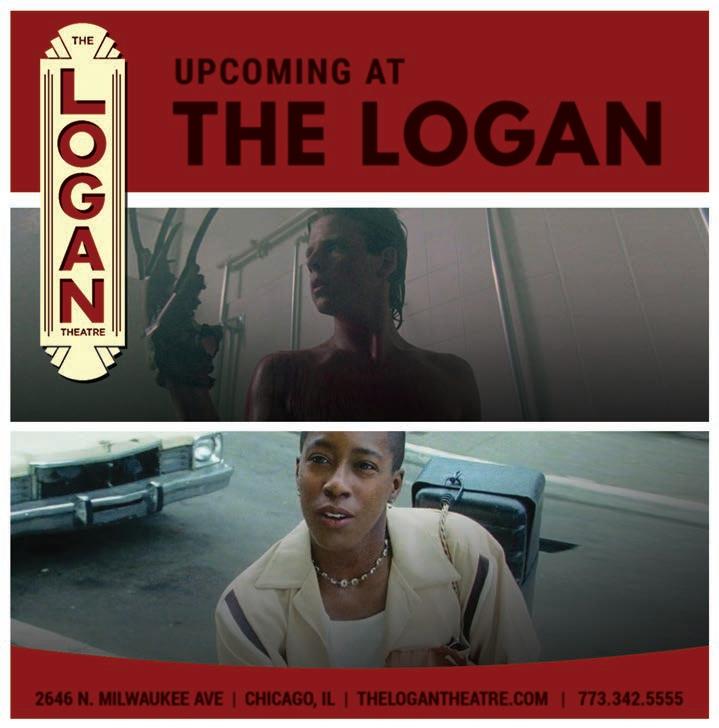










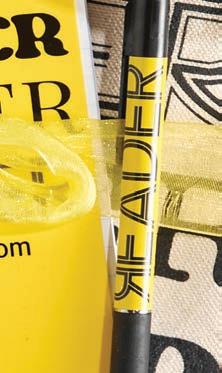


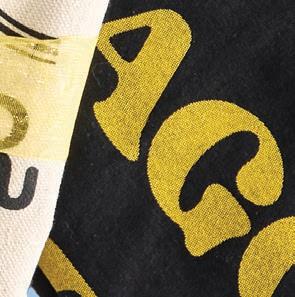










In fall 2003, writer and actor Dave Awl faced a pileup of crises. His work as a freelance copywriter wasn’t going well, and because the developers who’d bought his Andersonville apartment building were turning it into condos, he had to move out by the end of October. He also had to figure out how to cover a $2,500 deductible for hernia surgery, so he was struggling to find $300 to pay the moving company he’d hired. When the movers arrived, they took one look at his stu —a thousand books and a thousand CDs, plus hundreds of vinyl records—and told him they couldn’t manage it. “They took all my money, they moved about half of my stu , and they left,” Awl says. “I had to be out within a day or two.”
Awl needed help and fast. Since 1998, he’d been dancing at a weekly new-wave party called Planet Earth, launched in 1994 by nightlife veterans Dave Roberts and Kristine Hengl. In 2000 he’d created an online message board for the Planet Earth community, called Planet Earthlings, and that was where he turned in his hour of need. He didn’t even have enough money for the traditional moving-day pizza, but he o ered each volunteer a custom CD mix.
“Thirteen people showed up at my apartment that night to help me move,” Awl says. “It felt like an army just materialized. The fact that they did this when they knew I couldn’t
Dave Roberts and Kristine Hengl’s inclusive new-wave night also built its community with a message board run by gay writer and actor Dave Awl.
By LEOR GALILeven buy them pizza, it brought me to tears. I was so amazed that I had made friends who were that loyal and that supportive from us dancing together at a nightclub.”
Awl had been introduced to Planet Earth by a high school friend, Bart Todd Clifton, then a bartender at queer Uptown hot spot Big Chicks. At the time, in late 1998, the party was still happening on Thursdays at its original home in Lincoln Park, Club 950 (aka Lucky Number).
“It was packed,” says Paté, who bartended Planet Earth at 950. “Thursday was my favorite shift to work. I was working at multiple clubs at the time. Like an athlete getting ready for a race, Thursday nights I would eat, seriously, a bowl of pasta and get to work early.”
Awl probably would’ve found Planet Earth earlier if he hadn’t performed in the NeoFuturists’ Too Much Light Makes the Baby Go Blind for much of the 1990s. With his limited late-night free time, he’d already been to 950 a couple times, but Planet Earth immediately felt di erent.
“The first thing that Cliff did, he pointed out Dave Roberts walking by with his bleachblond flattop and said, ‘That’s the DJ,’” Awl remembers. “Like—look at that guy, wow. He was just so striking. I immediately was like, ‘OK, yeah, I wanna hear what he’s gonna play when he goes up to the booth.’” Awl danced till



950 closed at 2 AM.
Planet Earth moved out of Club 950 when the venue closed in 1999. It relocated briefly to Northalsted club Spin and then, in early 2000, to Neo, a long-running alternative nightspot a few blocks from 950. At first Roberts and Hengl had a little more trouble attracting a big crowd to Neo on Thursdays. Awl pitched them on the Planet Earthlings message board and




they were too shy.
“There were some really great conversations,” she says. “The beauty of it was that the person in the room that you noticed—you’d go every Thursday, and you’d see this person— then all of a sudden they’re on this online community, and they have a name and a personality. And they respond to things. I know, for sure, that there are lifelong friendships that were cultivated because of that online community.” Awl launched Planet Earthlings through messaging platform eGroups in December 2000. Yahoo! had bought eGroups the preceding August, and in early 2001 it migrated all eGroups communities into the newly launched Yahoo! Groups. By August 2001, Planet Earthlings was generating a couple hundred messages per month, and over the next few years it picked up steam; the group peaked in October 2004 with 1,267 messages.
Yahoo! Groups once hosted as many as ten million communities. In late 2019, Yahoo! owner Verizon announced that users would no longer be able to post to Yahoo! Groups. At the end of 2020, Yahoo! Groups shut down. Any group that hadn’t migrated elsewhere vanished, along with its entire history of messages, and Planet Earthlings was among them.
I learned about Planet Earthlings when Dave Roberts died in February 2023. I interviewed Awl for Roberts’s obituary, and he told me
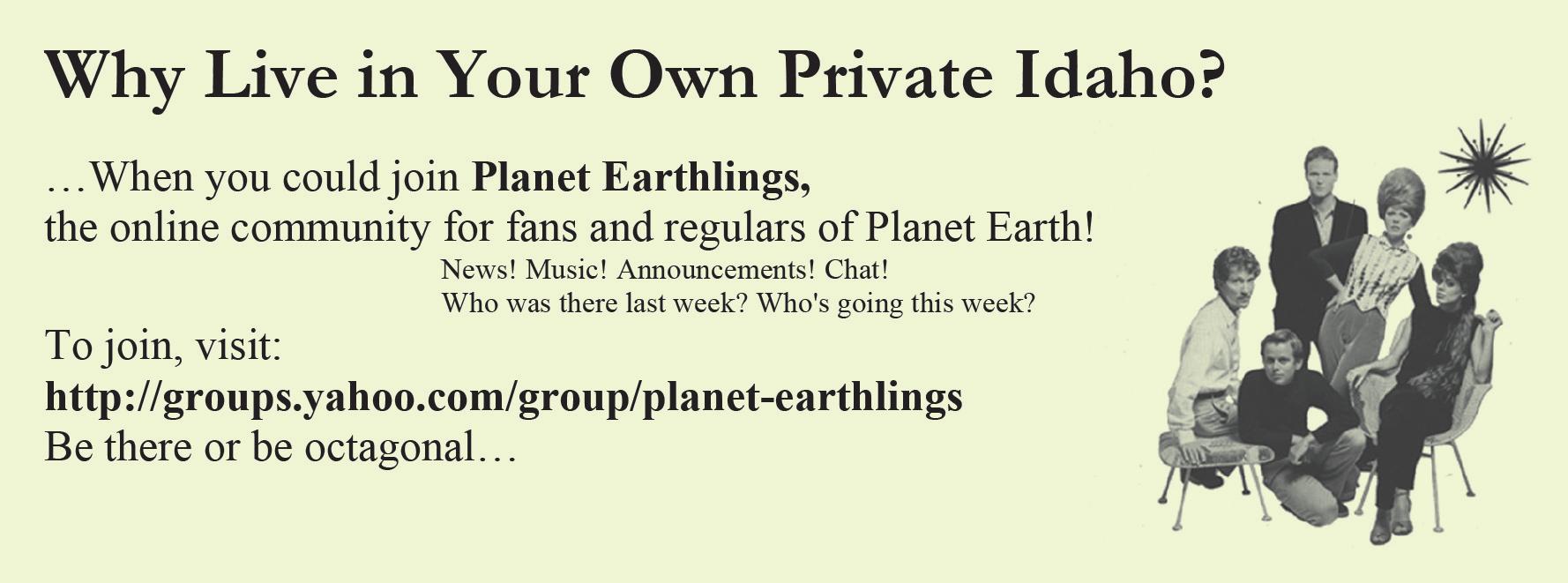
Dave Awl printed these Planet Earthlings invitations to hand out at Neo shortly a er the message board’s launch. COURTESY OF DAVE AWL
mailing list, and Hengl says his online work helped the night grow.
Hengl also liked the thought that the message board could break the ice between regulars who might not have talked at Neo, whether because it was too loud or because
about the Yahoo! Group and mentioned he’d saved some material from it.
A couple months ago, Awl sent me a folder of lightly annotated RTF files containing Planet Earth scene reports he’d written for the Planet Earthlings email list between February
2001 and February 2003. During that stretch, Awl sent a report almost every week, welcoming new members to the message board, documenting which regulars showed up, listing what Roberts and Hengl had played, describing the crowd reactions on the dance floor, and mentioning anything else that caught his eye.
“If you were a man wearing a pink tutu, you couldn’t hop in just anywhere. But you could at Planet Earth.” —Planet Earth bartender Paté

Nightlife is ephemeral by nature, and it doesn’t tend to inspire detailed documentation—when you’re partying in a small, dark club with your friends, you’re not usually thinking about writing anything down later. This makes Awl’s personal, detailed, and colorful scene reports all the more remarkable. Awl’s Planet Earthlings emails (I counted 80) total more than 70,000 words, enough to fill a book.
Planet Earth was a gay-friendly scene, with lots of LGBTQ+ regulars—Awl among them. “For my generation—and I’m defining this very narrowly as people who were in high school in the early 80s—if you were queer, if you met someone else who liked the B-52s, you knew they were gonna have a sense of humor, a sense of camp, and that they were gonna be OK with the gay thing,” Awl says.
Awl’s reports don’t foreground the queerness of Planet Earth, because it was an ordinary part of the water everyone swam in. But here and there he writes something that makes it legible. He might mention a sighting of locally famous queer poet Thax Douglas, shout out Cyndi Lauper for her LGBTQ+ advocacy (and for name-dropping gay men’s mag Blueboy in “She Bop”), or refer to Scott Free’s cabaret Grinder, which Planet Earth regulars sometimes attended before heading to Neo.
Planet Earth also drew a queer crowd because Hengl and Roberts made it a point for their event to be as inclusive as possible. When Roberts spun the Clash at Planet Earth, he’d refer to them by their famous nickname: the Only Band That Matters. Planet Earth regulars took to calling Roberts and Hengl the Only DJs That Matter.
Roberts was hard not to notice, with a bleached blond flattop that’d impress Ludwig Mies van der Rohe. But when
Hengl first saw him at the back of the WaxTrax! shop on Lincoln (she says she’s bad with dates, but it was probably the early 90s), she took note of his shoes.
“He had perfect Chelsea Beatle pointy boots with the Cuban heel—and I know things like this. It’s important, or it was,” she says. “He was a real smiley guy. He was like, ‘Hi, hi, hi.’”
Suddenly, it seemed like
Hengl was seeing Roberts at every alternative hot spot going. She’d run into him chatting with video jockey Leroy Fields at Lakeview juice bar Medusa’s or catch him spinning at Neo.
Hengl frequently bumped into Roberts at Smart Bar, where they’d strike up conversations. “He was a know-it-all, in a loving way,” she says. “Dave was always right. [He had] that confidence, and especially confidence to walk around on the streets not looking like everyone else.”
Roberts first kissed Hengl at Smart Bar, and after the club closed at 4 AM, he walked her back to her coach house near Berlin. They’d remain close for the rest of his life.
“My roommate at the time sees this man who’s got this huge hair and he’s wearing this long duster coat,” Hengl says, “and she’s like, ‘Who’s in our kitchen?’ I was like, ‘Oh, that’s Dave.’ That’s kind of how it happened. It was special.”
Shortly before Hengl and Roberts launched Planet Earth, a bartender buddy of Roberts’s named Ben convinced him to spin Thursdays at Club 950. “We were friends, and I would wander into the booth,” Hengl says. “I would help him when he had to go to the bathroom or had to go get a drink or had to deal with some situation.
That’s how Planet Earth started.”
950’s drab interior for Planet Earth, and one of her favorite tricks involved bunches of window screen. “If you kind of crinkle it and staple it up with a staple gun and put some good lighting in it, it looks like freaky clouds,” she says.
Hengl ran promotions for Planet Earth, which also involved bringing in guests to DJ or perform—often they were regulars from the club. “‘We know Herman loves the Smiths, so let’s ask Herman if he’d like to try DJing—he’s never done it before, but he loves it,’ so that’s the point,” Hengl says. “‘Let’s get Boa-Boa in, and he’ll do a big drag show.’ I just tried to come up with lots of ways to include people, because they were part of a community, and that was the whole point of Planet Earth.”
In 1993, Boa-Boa got a job working at Berlin. Born Mike Decker, he was a club kid, and he’d often throw raves at his Chinatown loft. He liked to travel all over the city in search of a good party, and because he had a car he could bring friends. He tended to avoid the strip of gay bars on Halsted in Lakeview, because he felt they were blandly
The Planet Earth crowd took pride in making everyone feel welcome.
KIRK WILLIAMSON

Hengl’s mom owned a flower shop when she was growing up, and as a teen Hengl participated in Steppenwolf Theatre’s summer camps. She had an eye for how to gussy up
Boa loved that Roberts could play songs for every subcultural clique that showed up to Planet Earth. “Whether you were a skinhead, the pool players, the gays, the lesbians, the bis, the drag queens, it didn’t matter,” he says. “Because you knew, if you were at the event, there would eventually be a set that’s 10, 15, 20 minutes that was for you, and that you were included. But the rest of the music was so good as well—you didn’t necessarily just dance for your set.”
Club 950 had a pool room with three tables, and Boa liked to show up in drag and play tough-looking skinheads. “I would kick all their asses,” he says.
Hengl and Roberts brought Boa aboard behind the bar at 950, along with Paté, who’d started bartending in 1985 and had become a legend in Chicago nightlife by the time she began working at Planet Earth. She’d earned her reputation while holding court at a small Northalsted gay bar called the Closet; she threw a monthly metal night there on Mondays, which drew straight and gay clientele.
“My kind of crowd was always a mixed crowd,” Paté says. “Gay, straight, bi, I didn’t care. If you were cool, I liked ya. That was the kind of place I wanted to hang at, and that was the kind of place I wanted to work at.”
Paté loved working at 950 on Planet Earth nights. “Back then you had to be careful, somewhat—as you still must, I suppose—what clubs you went to,” she says. “If you were a man wearing a pink tutu, you couldn’t hop in just anywhere. But you could at Planet Earth.”
Artist and writer Andrea Kaspryk came out as trans in the mid-1990s. “I missed out on the 80s because I was in the closet,” she says. “I didn’t venture out too much, and I regretted not going out in the 80s. I listened to some of the music. I finally thought, ‘Well, now is my chance to catch up a bit from what I missed out on.’ I was really eager to go out, to meet people, and hear the music that I listened to on my own, mostly— and make up for lost opportunities.” She started coming to Planet Earth in 2001.
interchangeable. He liked the mixed crowd at 950, particularly on Planet Earth nights. “Planet Earth was such an androgynous scene,” Boa says. “As long as you’re not dressed in a Cubs jersey, you’re gonna fit.”
Kaspryk had made attempts to go out at night before Planet Earth, but she usually ended up sitting o to the side reading a big book. She dropped that habit shortly after becoming a Planet Earth regular. “It really pulled me away from any sort of remaining tendencies I had to remove myself from life—at arm’s length away, just a filter, like a book,” she says. “It felt like I was directly participating in life again.”
continued from p. 25
While a Thursday night at Neo was still fresh in her memory, Kaspryk liked to visit the Planet Earthlings message board. It helped her hold onto her feelings from the dance floor. “Dave’s Yahoo! Group gave the group some cohesion, a sense of identity,” she says, “and a sense of prolonging the experience and enhancing it.”
In 2017, Kaspryk published a book of essays, poems, and visual art called Inner Journeys in Search of the Self . “On my native ground,

with bouquets of flowers,” Awl wrote. “Hooray for flowers! Kristine definitely knows how to win the heart of a Taurus boy.”
Awl’s densely detailed recap of that night tops 1,000 words. “It was sort of like having an unpaid journalism job at a certain point,” he says. “But because my whole world was revolving around that scene and those people, at least for a year or so it wasn’t hard.” The Planet Earthlings scene reports and message board also helped strengthen the community.
creating that vibe.”

At Planet Earth, Dave Roberts o en played what Dave Awl called “Homo sets” in his scene reports. These songs all made appearances in those sets.
“Smalltown Boy” Bronski Beat
“Lover Come Back to Me” Dead or Alive
“West End Girls” Pet Shop Boys
“Just Can’t Get Enough” Depeche Mode
“Oh L’Amour” Erasure

“Two Tribes” Frankie Goes to Hollywood
“Don’t Go” Yazoo
“Pretty Boys and Pretty Girls” Book of Love
“Don’t Leave Me This Way” The Communards
“Miss Me Blind” Culture Club
amidst the dance floor demimonde, the Planet Earth regulars who arrived early, I was dancing on top of the world: one chapter of my life had finally come to an end,” she wrote. “One of my greatest fears had been vanquished— dancing as my transgender self.”
According to a scene report Awl emailed on July 28, 2001, that month Hengl painted a banner promoting Planet Earth’s new website and hung it up inside Neo. Midway through the night, Hengl brought Awl and Danielle Christo el, the Planet Earth webmaster, onto the dance floor to help announce the site redesign. “We were also presented
“Gradually it became a room full of people where we all knew each other by name in addition to by face,” Awl says. In his scene reports, he liked to list the regulars who attended and those who missed out. He’d usually stick to first names, with some exceptions: “John P.” was Screeching Weasel cofounder and Neo-Futurist John “Jughead” Pierson, while “John Q.” was John Quale, a singer with an affinity for hot pants who later competed on America’s Got Talent as Prince Poppycock. Paté and Boa made appearances in the reports too.
Of course, the music that Roberts and less often Hengl spun at Planet Earth took up a lot of space. Sometimes Awl added commentary; in May 2001, he described Grace Jones’s “Pull Up to the Bumper” as “perhaps the bubbliest little ode to rear-entry ever recorded.” The blocks of songs with explicitly gay themes—“Homo sets” in scene reports—often included Bronski Beat’s “Smalltown Boy.” At a Planet Earth night in October 2021, Hengl dedicated the song “to a couple of boys apparently in the midst of a breakup,” Awl wrote, “sounding quite moved and saddened by it all.”
At the end of November 2001, Awl said that Planet Earth had drawn the biggest crowd he’d yet seen during its Neo run. For a few years at least, the crowd would continue growing, in part because Planet Earth began advertising in queer bar guide Nightspots , part of the Windy City Media Group run by former Reader publisher Tracy Baim. Current Reader production manager Kirk Williamson, a future Planet Earth regular, ran Nightspots as its editor, designer, and principal photographer, and in December 2001 Awl wrote that Williamson was giving Planet Earth a “v. generous ad deal.”
“I knew that all of Tracy Baim’s publications really had a strong presence in the women’s community,” Awl says. “I wanted to up the dyke quotient, because I wanted to add that to our diversity—and just get the message out there that it was a safe space for queer people, because that had always been so important to Dave and Kristine. They’d done a great job of
Not everyone who came to Neo during Planet Earth understood the vibe, though, and Awl documented that in his scene reports too. “There was a fellow at one of the side tables who kept pantomiming shooting a rifle at the dance floor,” he wrote in September 2001. “It seemed homo phobic in its intention and it was fairly disturbing.” Later that night, he spotted antigay gra ti in the men’s room. “It’s a good reminder that despite all e orts to make Planet Earth a safe space, not everybody who makes it in the door of Neo actually has opposable thumbs.”
Roberts and Hengl had the dancers’ backs and did their best to make sure everyone knew it. In summer 2002, a recently hired Neo door person with a trans phobic streak began policing the bathrooms, precipitating a conflict that Planet Earthlings called the Door Wars. Roberts and Hengl would soon bring the problem to Neo’s management, but in late August, Hengl addressed it on mike in the middle of the party. Awl typed her declaration in all caps: “PLANET EARTH IS FOR EVERYONE! WHETHER YOU’RE GAY OR STRAIGHT OR BLACK OR WHITE OR TRANSGENDER OR WHATEVER AND IF ANYONE HAS A PROBLEM WITH THAT COME FUCKING TALK TO ME.”
In December 2001, Roberts and Hengl invited Awl to spin a brief set at Planet Earth. He’d continue to make impromptu appearances behind the decks, and in scene reports he referred to himself as “DJ I Can’t Believe It’s Not a DJ.” Over the next couple years, Awl became more confident as a DJ, and through Roberts and Hengl he landed a weekly night at Ukrainian Village bar Club Foot, which he called New Toys for Glow Dogs.
As Awl put more time into Club Foot and his monthly variety show, called The Partly Dave Show, his scene reports began to taper o . The Planet Earthlings message board continued to grow for a couple more years, but the chatter peaked in October 2004 and then slowly subsided. By 2008, while an ascendant Facebook topped 100 million users and edged out MySpace as the world’s most popular social network, the Planet Earthlings message board couldn’t crack 100 new messages per month.
Planet Earth left Neo in March 2008 and went on hiatus for almost two years, aside from a couple events at Subterranean (and Roberts’s Planet Claire nights at Holiday

Club). Once Hengl and Roberts opened Late Bar in Avondale, Planet Earth moved there in December 2009, shifting to Saturdays to accommodate an aging crowd that had trouble staying out late on weeknights.
Planet Earth was still happening every Saturday when Roberts died in February 2023, and the series name was retired in his honor. Metro hosted a celebration of his life on March 4 where the speakers included Metro owner Joe Shanahan, Hengl, and Awl.
“Maybe the most magical thing Dave did was that he created a space where the subculture of outsiders and misfits who loved the new wave and punk music of the late 70s and 80s could celebrate that music by dancing all night, and also connect with each other to form a community of friends, breathing life back into that subculture,” Awl said onstage. “I know I’m not the only one here who gets by with a little help from the friends that they made on the Planet Earth dance floor.”
The Planet Earthlings community hasn’t dissolved, even though the message board nearly dried up in the early 2010s. For the most part, it’s migrated to Facebook. In late 2023, Hengl logged onto Roberts’s Facebook account to share a post announcing a future sale of his record collection and another promoting a run of Dave Roberts memorial merch. She hasn’t logged into Roberts’s account since, and it’s been mostly dormant. She’s entrusted its moderation to someone she knows will do right by Roberts and his legacy: Dave Awl. v
m lgalil@chicagoreader.com
WHEN LOCAL RAPPER and Why? Records cofounder Joshua Virtue dropped the album Rama in October 2022, they decided to change their stage name. “I started going by Rama around the same time that I put that album out, in my everyday life,” Rama says. “I wanted to feel more rooted into that. I want everything I do to be under that name now; it felt like a completion to start calling myself that.” Last week, Why? Records released Rama’s final album as Joshua Virtue, titled Black Box: Joshua Is Dead
The title doesn’t just refer to Rama’s decision to stop using their old stage name; the songs also explicitly grapple with death. The album Rama deals specifically with the idea of balancing the everyday against the knowl-
A furry ear to the ground of the local music scene
of the most inquisitive lyricists and heartfelt performers to emerge from Chicago hiphop in the past decade. They deliver existential tongue twisters with a reserved cool, and their searching observations and idiosyncratic details illuminate our likely fates when the social and physical infrastructure that sustains us finally collapses.
“I think the biggest effect [working on Black Box] had on me is that I no longer feel that it is my objective to transcend the fear of death—I’m more interested in accepting my fear of death, and allowing myself to feel that in a way that I guess I haven’t before,” Rama says. “Life is messy, and you’re always gonna feel a multitude of emotions at any given time. I don’t think that death inherently has to be a

dance label Yearning debuted with the 14-track compilation Yearning for Beauty . Founded by Michelle Hathaway (aka Misia) and Collin Kirk (aka Pharmacist), Yearning has since released the former’s Being Painless and the latter’s Kill Everyone Now —and the label is about to drop a second compilation. On Saturday, June 22, Podlasie Club hosts a release celebration for that comp, which begins at 9 PM with a listening party. Then Yves Novak and Eden Aurelius spin DJ sets, and local industrial reggaeton duo Conjunto Primitivo make their debut behind the decks.

edge of oncoming apocalypse, and that provided the seeds for Black Box. “I wanted to think about what does it mean to wander around in a death zone all day,” Rama says. “This was around the time of the pandemic, and there’s this genocide happening now. A lot of people are surrounded by death in their everyday life—not that they weren’t before, but it seems more pressing to confront that reality these days than maybe it did before, because it seems like something’s gonna kill you at every moment.”
That theme made itself increasingly apparent over the past couple years, as Rama wrote and recorded the music that would become Black Box . On the standout track “Physics” (with its refrain of “Physics doesn’t care”), Rama demonstrates what makes them one
clean thing like we imagine, ’cause most peoples’ deaths aren’t clean—that must be OK, because that’s just reality.”
Rama has released Black Box as a paywhat-you-want download through Bandcamp. All proceeds benefit their mother, who is in a “time of great need,” as Rama puts it. “It felt good to make some fucking money for my mom,” they say, “because that’s the whole point of this thing sometimes—to give and create, even if it’s for a moment, a gi for someone else. Like, it’s its own singular gi , and I can use it as a gi for others. Art has always carried me, so I’m trying to hold more faith in that and allow it to do that, without also having to reach for this marginalized idea of what success through art should look like.”
IN NOVEMBER, CHICAGO underground
PRIDE MONTH IN CHICAGO isn’t leaving you wanting for options to celebrate queer audacity, queer communion, and general gay shenanigans. On Sunday, June 23, Gyrate takes over rooftop bar Cerise at the Virgin Hotel for a little dayparty moment. DJ and producer Mamicana founded the monthly party almost three years ago to ensure that folks who crave the music of the Black and Caribbean diaspora—dancehall, reggaeton, soca, Afrobeats—would have a time and place to commune with it. From 3 PM to 9 PM on the 26th floor of 203 N. Wabash, Mamicana will join DJs Dyaspara and Mary Domino on the ones and twos. CEO and founder of Body Confidence for Queens, dancer Mocha Mocha2.0 , will perform at the party too. A day with Gyrate is damn near synonymous with a day with the gays.
Genderqueer lesbian dance party Strapped, which usually takes over Empty Bottle the first Friday of each month, visits Wrigleyville on Friday, June 28, for a full-building blowout at Metro and Smart Bar . At Super Sapphic III , more than a dozen performers and DJs will keep the party going strong from 9 PM till 4 AM. At Smart Bar the music is by Jenny Fox and Karennoid (in a B2B set), TRQPiTECA , and Virago ; upstairs at Metro it’s by Vitigrrl, Stasney, and Icey Bby. The stacked bill at the function also includes dancers Angelíca Grace, Fierce, and MochaMocha2.0 and performances by Ramona Slick, Darling Shear , and Strapped curators Irregular Girl and Siichele Pepper Jelly, Party Mom Kristen (aka former Reader staffer Kristen Kaza), and Your GodMutha Tristen host. —DMB (DEBBIE-MARIE BROWN) AND LEOR GALIL

The 1990s Chicago trio sputtered out a er one ambitious album, but Sex Vehicle more than merits its new reissue.
By STEVE KRAKOWSince 2005 Plastic Crimewave (aka Steve Krakow) has used the Secret History of Chicago Music to shine a light on worthy artists with Chicago ties who’ve been forgotten, underrated, or never noticed in the first place.
The Secret History of Chicago Music has been hesitant to cover acts from the 90s—I’m a Gen Xer, and that seems too recent to me. But I’ve already written about Plastics Hi-Fi and the Joy Poppers, and their stories were as fun to tell as any from decades further gone. Plus it’s gratifying to learn more about artists I loved and actually went to see as a lad! Today’s installment follows the journey of Motorhome through the celebrated 90s Chicago alt-rock scene. This hardworking band made fuzzy pop-rock that’s heady, fun, and distinctively theirs.
Motorhome guitarist and vocalist Josiah Mazzaschi grew up in Boston, and as a young skate punk, he pounded the skins in hardcore bands. He loved Chicago’s Wax Trax! scene too, and played digital drums in a gothic industrial group called Kiva. Mazzaschi didn’t switch to guitar till the late 80s, after he heard My Bloody Valentine. In the early 90s he moved to the Windy City to attend the School of the Art Institute.
Mazzaschi promptly began seeking out other musicians in Chicago. In early 1993, he met fellow SAIC student Kristen Thiele while she was on the job at Jimo’s, a Wicker Park restaurant tucked into a corner next to the future Double Door space. (There’s a shuttered Foxtrot there now.)
Thiele was born in Honolulu and raised in Miami, and as a kid she played violin and
piano. She loved the Velvet Underground, the Cure, the Modern Lovers, Bad Brains, and Government Issue. Rat Bastard, a notorious figure in the Miami punk and noise scene, convinced her to pick up an instrument in 1991.
“I had been wanting to for a long time, and his suggestion pivoted me into action and doing something about it,” Thiele says. “I bought my primary bass, my Gibson G3 that I played for many years, for $300—including the amp.”

When Mazzaschi met her, Thiele was already making music with drummer Laura Ann Masura—they’d met at a downtown bar called Cairo earlier in 1993. For Mazzaschi, this was an ideal development: Thiele came with a drummer!
Masura was born in North Carolina, and her family settled in Elk Grove Village when she was six. Her early musical influences include Bauhaus, Siouxsie & the Banshees, Minutemen, and the Jesus Lizard. She played percussion in marching and concert bands in high school, but she gave it up for visual art.
After graduating, Masura worked informally for Smashing Pumpkins and became good friends with drummer Jimmy Chamberlin. When he learned about her history with
drumming, he took action. “Jimmy gave me his old Pearl set when he got his Yamaha endorsement,” Masura explains. “Then he gave me a few lessons, and maybe a week later I met Kristen and told her how I just got a drum set.”
The band started jamming as a four-piece that briefly included the late Eli Miller, former guitarist of New Radiant Storm King. “He and I came up with the name,” Mazzaschi says. “We took turns randomly putting our finger in the dictionary, and his finger landed on ‘motorhome.’” Miller wasn’t impressed by the women’s playing, though, and Mazzaschi had to choose between him and them.
Once Motorhome became a trio, Thiele wrote about half the tunes, adding dreamy vocals reminiscent of Elizabeth Fraser from Cocteau Twins. Mazzaschi wrote the rest, and all the band’s material benefited from his heaps of guitar pedals and other gear, which he used
to create hallucinogenic textures, loops, and sound collages. Masura’s heavy stomp gave the band a punky drive.
Motorhome attracted major-label attention during the feeding frenzy that had erupted in Chicago, but wisely, they signed with an indie—Angela Strachan’s New York label Dirt Records. “Angela Strachan used to come into the co ee shop I worked at on Damen and Milwaukee,” Mazzaschi explains. “Turns out she was a DJ at WFNX in Boston, and I grew up listening to her voice! I gave her a demo cassette, and the next time I saw her, she asked me if we wanted to be on her label.”
Dirt released two dizzying 45s by the band, “Whole in My Head” in 1994 and “Sweet Valentine” in ’95, as well as Motorhome’s ambitious debut album, Sex Vehicle , which also came out in ’95. Its 21 tracks include lo-fi interludes, suites of interlocking compositions, and a
dazzling diversity of studio trickery, all in service of infectious melodies.
“This coed trio combines the exotic petulance of fellow Chicagoites Smashing Pumpkins with the lush, dissonant texturings of dream-poppers like My Bloody Valentine and Blur,” wrote Entertainment Weekly in an A- review. “The satisfying result is that rarest of indie rock feats: an una ected balance of quirkiness and catchy, stick-to-your-ribs hooks.”
Motorhome recorded Sex Vehicle at Kingsize Sound Labs in Humboldt Park, incorporating lo-fi material they’d taped at home. “Kristen and I lived in a loft with Kristen’s friend Amanda and David Nooks from the Wesley Willis Fiasco,” Mazzaschi says. “We recorded all of the four-track songs on Sex Vehicle there.”
Frustratingly, gentrification around the intersection of Lincoln, Ashland, and Belmont led to Motorhome’s eviction from the loft shortly before the release of Sex Vehicle. “We were really close friends and rehearsed almost daily. We lived and breathed music in the Motorhome loft,” Mazzaschi recalls.
Dirt Records connected the band with a booking agency, and on the agent’s advice they quit their jobs and hit the road. “Our biggest show was opening for Alanis Morissette in Cincinnati,” Mazzaschi says. Motorhome’s T-shirts had a UFO on the front (with the words “Motorhome” and “Sex Vehicle”) and a planet with a palm tree on the back (with “Aloha from Uranus”). “Kids were buying our shirts like crazy—they thought it said ‘Aloha from Alanis,’” Mazzaschi remembers. “A couple kids wanted their money back!”
Demands for refunds weren’t the worst problem the band encountered on that tour. The agency had neglected to book the last four weeks of shows. “The booking agent stopped returning our phone calls and left us stranded in North Carolina,” Mazzaschi says. “Luckily we were able to get our jobs back!”
Motorhome fared better opening for beloved indie bands, among them Dirty Three, Cornershop, Ivy, Th’ Faith Healers, and Rollerskate Skinny (I was at those last two, using a fake ID). In 1996, though, Masura left the group—at the time Mazzaschi explained that he and Thiele were looking for a di erent kind of drummer, and Masura says she wanted to tour more than the others could. (She’d go on to play with the Prescriptions and Evil Beaver, both of whom released music through the Johann’s Face label.)
Motorhome replaced Masura with the late Bill Talsma (who played in Bunny with Miller), and he drummed on the 1996 single “My Spaceman” b/w “Little Bird.” Talsma left toward the end of 1997, and the group recorded the 1999 mini album Man of the Future with Mazzaschi doubling up on drums. New drummer Matt Espy (currently with Dead Rider) came aboard in time for the release show that May. (I was friends with Talsma, and tragically he took his own life in 2019. RIP, Bill.)
Thiele and Mazzaschi had become a couple, and as so often happens, they broke up and the band followed. Motorhome played two last shows in 1999, one at Metro with Espy and another at Double Door with Masura.
Masura moved to Los Angeles in ’05 and “retired from rock ’n’ roll,” as she puts it. But she still jams—that is, she runs Laura Ann’s Jams, making spreads such as “Lo-fi Marionberry” and “Rockin’ Jalapeño.”
Mazzaschi started his next project, Light FM, in 1999, and in 2005 he moved to LA himself. Not long after, he started a studio in his practice space, christening it the Cave. “I’m currently working with Louise Post of Veruca Salt on a new solo album,” he says. Mazzaschi also plays in the band Child Seat, whose second album, Dancing at the Disco , comes out this week via his label Moonboot! Records.
Thiele returned to Miami and opened an art studio and project space called Bridge Red Studios with her father, sculptor and painter Robert Thiele. She also teaches drawing and other studio arts at Miami Dade College and Oolite Arts.
I decided to publish Motorhome’s story now for a reason: last month Moonboot! reissued Sex Vehicle (remastered by Mazzaschi), and rereleases of Man of the Future and “My Spaceman” may follow.
Mazzaschi, Thiele, and Masura remain friends, and they’ve all told me they’d love to find a way to make a Motorhome reunion happen. Masura even says this piece “may spark some new songs and a show or two.” That’s the sort of thing I always hope will happen when I cover living musicians in Secret History—and it’s a good argument for writing about more 90s bands!
The radio version of the Secret History of Chicago Music airs on Outside the Loop on WGN Radio 720 AM, Saturdays at 5 AM with host Mike Stephen. Past shows are archived at outsidetheloopradio.com/tag/secrethistory-of-chicago-music.


IN 2021, LIFEGUARD singer-guitarist Kai Slater began publishing Hallogallo, a zine that documents the young Chicago indie-rock scene that’s taken the Hallogallo name as its own—he’s not just an active member of this community but also a kind of figurehead. Slater’s zine provides a window into his own tastes too, and he’s interviewed some big stars, including Michael Rother, cofounder of Krautrock giants Neu! (whose song “Hallogallo” gave the zine its name). Slater has done a particularly great job digging beneath indie rock’s topsoil to document lesser-known DIY figures whose homemade charms have attracted cult followings, among them Cordelia Records founder Alan Jackson (issue six) and Graham Smith, aka Kleenex Girl Wonder (issue five). Smith’s rough-and-tumble power pop provides a clear point of reference for the kind of imaginative songs Slater records under the name Sharp Pins.
I knew Slater was talented before I heard his solo work, since I’ve written about lots of the music that he and his colleagues have made over the past few years—much of which has attracted significant attention from outside Chicago. But I was still unprepared for the debut Sharp Pins album, last year’s Turtle Rock. Slater applies a touch of Lifeguard’s discordant sound to dreamy, straightforward songs jammed with hooks, using a lo-fi approach that makes these songs feel lived-in and timeless, like I’ve known them all my life. On last month’s self-released Radio DDR, Slater supersizes that sensation—the new album sounds bigger, tighter, and dreamier than its predecessor. The fluttery overdubbed vocal harmonies on the back half of the swooning “Lorelei” shine out like a sunbeam breaking through the clouds after a summer downpour. Slater made most of Radio DDR by recording all the parts himself, but on the easygoing “Race for the Audience” (the album’s lead single) he enlisted bassist Joe Glass and drummer Peter Cimbalo, who both accompanied Slater on Sharp Pins’ May tour. Slater kept Radio DDR off streaming platforms for a few weeks after release to encourage people to buy it from Bandcamp, because he’s donating all proceeds to the Palestine Children’s Relief Fund.
This Sharp Pins headlining set is part of New Static! Revival Now, a youth-scene mini fest that combines Eli Schmitt’s monthly New Now series with a preexisting festival called Static Revival, organized by sibling shoegaze duo Twin Coast and debuted at Subterranean last September. The lineup offers a great snapshot of the evolving scene: Twin Coast, Schmitt’s band TV Buddha, postpunk trio Uniflora, and Donkey Basketball, the IDM project of Lifeguard drummer Isaac Lowenstein. Twin Coast singer-guitarist Reid Isbell just published the first issue of a zine called Static! Revival, which will be for sale. —LEOR GALIL
THURSDAY20
Sharp Pins See Pick of the Week at le . Twin Coast, TV Buddha, Uniflora, and Donkey Basketball open. 7 PM, Schubas, 3159 N. Southport, $15. 18+
FRIDAY21
Kumbia Queers See also Sat 6/22. DJ Future Rootz opens. 9:30 PM, Beat Kitchen, 2100 W. Belmont, $25, $22 International Latino Cultural Center members. 17+
In 2007, six Buenos Aires musicians—veterans of iconic Latin American punk bands, including Argentina’s She-Devils and Mexico’s Las Ultrasónicas— joined forces to create their own kind of cumbia. Their feverish, vibrant, and decidedly queer take on the venerable genre sounded light-years away not just from the usual wedding-celebration favorites but also from the grungy cumbia villera style that had exploded in Argentina in the mid-90s. On their debut album, 2007’s Kumbia Nena! , the band reworked classic punk, rock, and pop songs from the likes of Madonna, Nancy Sinatra, and the Ramones by adding cumbia’s ultracatchy syncopated rhythms and original lyrics that use humor and irony to criticize right-wing politics and denounce violence against women. Seventeen years and five albums later, they’ve pared down to a fivepiece, and they’re widely regarded as the OGs of a cumbia sound that soundtracks feminist marches throughout Latin America. Their latest single, April’s “Toco Madera,” is music to unite anyone who dares to think the world can be a better place. Its tropical punk cumbia hangs tightly to a rebellious, raucous joy that comes from celebrating the good times that buoy us through the struggle and using music and dance as an amulet to ward off sorrow. —CATALINA MARIA JOHNSON
Kumbia Queers See Fri 6/21. Part of the Levitt VIBE Belmont Cragin Music Series, held behind the Riis Park field house. 2 PM, Riis Park, 6100 W. Fullerton. F b
Jake Meginsky 3 PM, Experimental Sound Studio, 5925 N. Ravenswood. F b
You’ll never lack for things to do on a summery Sunday a ernoon in Chicago, but the Option Series is one of a kind. Curated by musicians Andrew Clinkman, Lily Glick Finnegan, and Ken Vandermark, it presents weekly performances and conversations with improvising musicians in the backyard of the Experimental Sound Studio (in the event of rain, things move inside). Jake Meginsky’s concert is the third on the 2024 schedule, which began June 9 and will run through the end of August. Based on

the east coast, he’s released several LPs of tactile, fluidly rhythmic music using modular synthesizers, but he’s probably best known for collaborating with American director Neil Young to make the docu-
mentary film Full Mantis , a feature-length portrait of drummer, healer, educator, and martial artist Milford Graves. A er talking and playing his way into a gig as Graves’s student and assistant in 2004, he
sustained a relationship with the drummer until his death in 2021. Graves’s ideas inform Trinities (Poole Music), which Meginsky recorded shortly a er his mentor’s passing; Graves saw the number three as a key to understanding rhythmic meter and grasping how concepts, their opposites, and the interactions that connect them can be part of the same energy. On most of the record, Meginsky’s electronically generated sounds evoke the shimmering, chiming resonance of Harry Bertoia’s metal sculptures and the echo-saturated drums on Sun Ra’s albums from the early 1960s, and he deploys them in intricate, constantly permutating configurations. The track “2521” departs from that model, though; Meginsky devised its complex but soothing textures to subdue the cacophony of the hospital where his wife was confined while birthing their child during COVID lockdown.
—BILL MEYERSaami Brothers 7 PM, South Asia Institute, 1925 S. Michigan, $50, $75 VIP. b
The singers in Pakistani ensemble the Saami Brothers like to take their time onstage—each vocal step moves the performance upward gradually toward a collective sense of ecstasy. That deliberate pacing is in keeping with the long, slow development of the qawwali tradition, which has been growing for more than 800 years. Qawwali has origins as 13th- century Sufi devotional music, and it’s often
handed down within families. Rauf, Urooj, Ahmed, and Azeem Saami studied under their father, maestro Naseeruddin Saami, and the family can trace their musical lineage to the idiom’s founders. The Saami family was featured in the 2018 Swiss documentary Closer to God , which depicts divergent Pakistani spiritual journeys. Their ensemble doesn’t have any full-length albums available, but it’s easy to find YouTube clips—such as “Baro Ghi Key Diye & Rasiya Alo Na”—that illustrate their incredible technique. They push forward dramatic vocal dynamics with a stirring call-and-response between the lead voice and the ensemble, subtly reworking repeated phrases that ultimately praise the divine. Sometimes lead vocalist Rauf Saami will erupt into hair-raising ululations, but he does so to advance the sound of the entire group rather than draw attention to himself as an individual virtuoso. Small hand drums (usually dholak and tabla) that move from background to foreground contribute to the tension, as do harmonium lines that weave among the singers’ pitches. Along with qawwali, the brothers are also experts in khayaal, a form of classical music that originated in northern India and uses the melodic frameworks of ragas to launch improvisational flights. The Saami Brothers’ most recent Chicago performances have been at private events, so this South Asia Institute concert is a valuable opportunity for the larger public to participate in the sense of community their music invokes.
—AARON COHEN



continued from p. 31
Jean Deaux Shawnee Dez opens. 8 PM, Lincoln Hall, 2424 N. Lincoln, $25, $22.50 in advance. 18+
Last spring, Chicago R&B artist Jean Deaux performed a show while recovering from laryngitis, and it turned out she wasn’t nearly healed enough: she caused herself a vocal injury that kept her offstage for a year. “I had to go see a specialist and they told me I had to be on vocal rest for a long time and I’m still in recovery,” she told Billboard last month. “It was scary because at one point I was like, What if I’m cooked?” Fortunately, Deaux has pulled through. In April, she released the EP Nowhere, Fast (Guin), her first release since splitting with mega indie label and distributor Empire, and she sounds poised and reinvigorated. On “TWUG (That’s What U Get)” Deaux’s svelte voice glides across the instrumental track, whose coruscating synths and palpitating percussion create a glossy, reflective surface that helps her subtle flourishes sparkle. —LEOR
GALILCedric Burnside See also Wed 6/26. Nathan Graham opens. 8 PM, Schubas, 3159 N. Southport, $25, $20 in advance. 18+
Singer, guitarist, and drummer Cedric Burnside comes from a long line of blues performers; his grandfather is cultishly beloved guitarist and singer R.L. Burnside, and his father is blues drummer Calvin Jackson. He started touring at age 13 and had roughly 30 years of experience under his belt by the time he won his first Grammy for the 2021 album I Be Trying (Single Lock). Burnside’s latest release, April’s Hill Country Love (Provogue), is a worthy follow-up. His tough, churning electric blues style owes a debt to amped-up rough-and-ready ax wielders such as Hubert Sumlin and Hound Dog Taylor, but he also channels the stripped-down, visceral

brutality of blues-influenced punk rockers, especially the Stooges. Listening to Hill Country Love is like being methodically slapped upside the head by whiplike guitar strings studded with bits of winking humor—on the title track, when Burnside sings “gonna spread a little hill country love,” the euphemism is direct and clear. The unrelenting rhythms that pulse throughout the record are part of the joy, but when Burnside does switch things up—as on the acoustic Fred McDowell classic “You Got to Move” or the James-Brown-by-way-of-Junior-Wells funk monster “Funky”—the change feels like a storm breaking. Burnside sounds even rawer onstage than on his albums, and every show offers unflinching proof that the blues live on. —NOAH BERLATSKY

WEDNESDAY26
Cedric Burnside See Tue 6/25. Nathan Graham opens. 8 PM, Schubas, 3159 N. Southport, $25, $20 in advance. 18+
Pallbearer, Rezn, the Keening 8 PM, Thalia Hall, 1807 S. Allport, $25 general admission, $35 seated balcony. 17+
Mind Burns Alive , the new fifth studio album by Pallbearer , is a strong, diverse effort that weaves existential emotional vulnerability through a crush
of heavy doom with progressive spacey pacing. Little Rock’s loudest exports are experts at building tension, and when they do finally deliver a payoff, it emphasizes the confl icted hopes and naked longing and sorrow of the record’s more wistful passages. The band also add fl ourishes—the sinuous beehive saxophone threaded through “Endless Place,” the classic slow hard-rock guitar of the title track—that show their confi dence in their patience and power.
For most of Pallbearer’s spring tour in support of Mind Burns Alive, they’ve been joined by mighty Chicago quartet Rezn , who are promoting their own new record, Burden . They recorded Burden at the same time as last year’s Solace , but rather than release them as a double album, they opted to divide the material thematically. Giving the gentle, upli ing songs on Solace time to breathe before dropping the Burden was a wise decision: this dark, bleak material demands and deserves your full attention. Closer “Chasm,” which features a guitar solo from Mike Sullivan of Russian Circles, packs a lot of power into a relatively economical package (by doom-metal standards), leaving a roiling surge of aftereffects. Burden isn’t unrelenting, though, and it sometimes plays with contrasts of its own—the light space-rock synths on “Descent of Sinuous Corridors” create a meditative interlude leading into the folkish opening of “Bleak Patterns,” which quickly turns lead-heavy and gothic.
Rounding out this excellent bill is the Keening , the Portland-based solo project of vocalist and guitarist Rebecca Vernon, formerly of Salt Lake City doomy folk-metal greats SubRosa. Her debut album, Little Bird (which came out on Relapse in October), features an all-star cast of collaborators, among them the record’s two producers, engineer Billy Anderson (on guitar) and Witch Mountain cofounder Nathan Carson (on drums). The record brims with haunting melancholy in its fusions of dark folk, Americana, and goth rock. —MONICA KENDRICK v

Health Care Service Corporation seeks Business Analyst (Chicago, IL) to work as a liaison among stakeholders to elicit, analyze, communicate and validate requirements for changes to business processes, policies and information systems. REQS: This position reqs a Bach deg, or forgn equiv, in Tech or Bus Admin or a rel fld + 2 Yrs of exp as a proj mgr, sys analyst, or a rel position. Telecommuting permitted. Applicants who are interested in this position should submit a complete resume in English to hrciapp@bcbsil.com, search [Business Analyst / R0026599. EOE].
Tate & Lyle Solutions USA LLC seeks Senior Network Engineers w/ Bach or for deg equiv in CS, EE, Electron Eng or rel fld & 2 yrs exp in job offer or in lrge scle dsgn, impl & suprt bldg cmplt LAN/SDWAN sltns incl exp w/BGP, EIGRP rtng & WAN/SDWAN suprt; in unif comm dsgn & deploy incl Avaya, Microsoft, Cisco voice/video. Telecom permtd. May rsde anywhr in the US. Apply online at https:// careers.tateandlyle.com/ global/en or to HR, 5450 Prairie Stone Pkwy, Hoffman Estates, IL 60192
Workday Payroll Specialist Workday Payroll Specialist, AbbVie Inc., North Chicago, IL. Serve as a key Liaison for Workday Payroll functional team to provide support and remediate the Payroll and HCM modules. Serve as the primary Workday configuration and reporting professional for functionality but limited to Payroll, Benefits, Compensation, Core HR, Time Tracking and General Ledger. Utilize systems/ analyst experience in payroll and HR modules. Design and Develop Reports, Complex Calculated Fields using Report writer and integration solutions in Workday using EIB’S, Custom Reports or RaaS solutions. Serve as a key liaison between business teams, 3rd party vendors and IT for system integrations and issue resolution. Build Advancedz Calculated Fields using Report Writer and integrations using EIB’s to support client’s requirements. Work with APIs within the Workday environment using REST or SOAP and XSLT and XML programming Language. Utilize knowledge of Workday and experience integrating with 3rd party applications. Support pre and post payroll activities and payroll audits (e.g. Exempt/Nonexempt Term Audits, CA Audit Reports, High Gross/High Net
Audits, Zero Net/Zero Gross, Review master data file quality and confirm time/payroll data completeness). Utilize knowledge of ERP, Workday System Concepts and HCM, payroll module functionality. Assist in resolving input errors and other errors from the third-party vendors or internal AbbVie (Tax, Treasury, Finance and BHR) stakeholders performing root cause analysis. Support Year-End Payroll processing activities (e.g. develop and provide payroll calendar, review year-end tax reports and notify AbbVie employees of availability of tax information. Design, document, build, unit test and support functional tasks, configuration, and programs for Workday HCM and Payroll projects. Research and participate in update training to keep up to date on new Workday functionality to make recommendations for adoption. Support data extraction, audit controls and data quality alerts. Provide end-user support with troubleshooting and issue remediation. Research problems and identify opportunities on suggested solutions with escalation management to Workday Second Level Support team. 100% telecommuting permitted. Must possess a Bachelor’s degree or foreign academic equivalent in Technology Management, Business, or a closely related field of study with at least three (3) years of related experience in the following: (i) knowledge of HR Business Processes like Job Change, Hire, Compensation change, termination; (ii) experience in inbound/outbound integrations Using Workday Studio, managing business processes, working with EIB, Report Writer, creating workday calculated field and Custom Reports and Financial Management Services; (iii) utilizing XML and XSLT and Web Services technology to transform input within EIB/Studio as per the API webservice request; (iv) knowledge of Workday and serving as a key liaison between third parties and stakeholders to define, implement, design and develop workday and other 3rd party interfaces. 100% telecommuting permitted. Apply online at https:// careers.abbvie.com/en & reference REF25665J. Salary Range: $83,616 - $134,500.00 per year.
Research Engineer Aquatic Group is seeking a Research Engineer in Chicago, IL. Deliver custom software solutions including investigating novel research ideas &
evaluating w/ large-scale experiments. Must live w/in normal commuting distance of worksite.
Email res to HR@ Aquatic.com & ref code 88860 in subject line.
Software Developers Software Developers, Schaumburg, IL: Analyze the requirements and gathering specifications based on technical needs. Offer inputs to SDLC (Software Development Life Cycle) documentation specialists and edit documentation. Assists in the day-today maintenance and improvement of the Enterprise Resource Programs and related systems. Travel/reloc to various unantic locs throughout the U.S. Send res to: Rigelsky, Inc. at 120 W Golf Rd, Suite 106, Schaumburg, IL 60195 or email: info@rigelsky.com
Salesperson Salesperson (Bridgeview, IL), Respon for selling custom cabinetry, account management, & business development. 18 mths + of exp as a salesperson, sales specialist, sales consultant. H.S. dipl or equiv. Send resume & letter of interest to T&J Woodworking, 7322 West 90th St., Bridgeview, IL 60455.
Medline Industries, LP in Mundelein, IL is seeking Sr. IS Business Analyst(s) (SAP OTC) to define, doc, dsgn, implmnt & sup’rt SAP ECC & allied SW solut’ns to meet biz objectives. No trvl; WFH bnft avail. Post’n reqs off-hrs sup’rt as needed, incld’ng on-call rotation. Apply at: https:// med line.taleo.net/career section/md confiden tial/ jobapply.ftl?lang en& job=INF01013J
Managing Principal Chaucer America, Inc. - Chicago, IL. Req: Master’s in Eng Management, Computer & Info Tech or rltd + (12) mths of rltd exp & in IT Projects. Send resume to: Vanessa. heintz@chaucer.com
Quantitative Researcher – PhD CTC Trading Group, LLC seeks Quantitative Researcher - PhD in Chicago, IL. Analyze market data and market microstructure. Contribute to production trading through research. Apply @ www. jobpostingtoday.com #48796.
Senior Technology Analyst Senior Technology Analyst: Dsgn & dvlp Software using .Net, C#, Angular, Powershell, WebServices, & SQL Database, incl adhering to best practices & standards in dvlpmnt, tech, & security. Dsgn & dvlp
solutions using .Net, C#, Angular, Powershell, WebServices & SQL Database. Manage the source control on Azure & GitLab. Analyze & translate biz reqmnts into tech reqmntss for dvlpmnt & create design docs & tech specs. Supervise comp programmers & serve as project leader for systems projects. Communicate w/project mgmt about status of work & any issues w/work progress. Lead projects w/ clients. Provide post-implementation support to clients, incl, but not limited to, monitoring performance & debugging/correcting codes. Sal $82K/yr. Reqs: Bach’s deg in Compr Sci, IT, Comp Engg, or rel fld. Resumes to: Systems Guild, Inc., Attn. HR, 1800 W Hawthorne Ln., West Chicago, IL 60185.
Northwestern Memorial Healthcare seeks Cytogenetic Technologists for Chicago, IL location to perform test procedures in the Human Genetics Lab. Bachelor’s in Med Tech/Clinical Lab Sci/Cytotech, Biotech/ Genetic Eng/related field req’d. Req’d skills: ASCP CG eligible. Eligible as Testing Personnel under the CLIA 88 regs. Background check & drug screen req’d. Apply online: http://jobseeker.nm.org/ Req ID: REF65701A
Medline Industries, LP in Northfield, IL has multi open’gs: A) Sr. IS Developer Analyst(s) (RPA) for full proj dvlpmnt, implemnt’n, & deploymnt. Apply at: https://medline. ta leo.net/careersection/ md_confidential/jobapply.ftl?lang en&job IN F01013H B) Lead IS Developer Analysts (Automation Development) to anlyz & assess automat’n feasibility. Apply at: https://medline. ta leo.net/careersection/ md_confidential/jobapply.ftl?lang en&job IN F01013I C) Lead Business Analyst(s) to sup’rt & implemnt solut’ns to biz challenges. Apply at: https://medline.ta leo.net/careersection/ md_confidential/jobapply.ftl?lang en&job IN F01013G All posit’ns: No trvl. WFH benefit avail; must be in office at least 2 days/wk.
Automations/Electrical Eng. One Rail Group seeks a Automations/ Electrical Eng: Req MS in EE, Automations Eng, or reltd & 3yrs exp as an Automations Eng. Req approx. 10% domestic travel. Wage: $103,896/ yr. Position in Romeoville, IL. EMail CV to ATTN: Jeffrey Heisen, 463675, jheisen@ onerailgroup.com. EOE
Logistics Coordinator- WH & Distribution Franklin Park, IL. Handle day to day assigned warehouse functions; resp for timely & accurate distrib’n of inbound & outbound freight, special projs & comm’ns w/ other depts.; verify shipments for accuracy & doc any discrepancies; handle issues w/ shipment overages or shortages; Follow all forklift fleet & sched preventative maint checks & processes. Req’rd: High School/GED & 2 yrs’ exp in warehouse & distrib’n oprns. Mail resume to Rachel Kim, HR Team Manager, FNS, INC. at 1545 Francisco St, Torrance, CA 90501.
Architect V Sheehan Nagle Hartray Architects, Ltd. in Chicago, IL seeks an Architect V to be responsible for finished plans, specifications, or approvals of materials and construction. Supervises and manages project teams at a project wide level. Master’s degree in Architecture or related field plus five (5) years of experience in the job offered, Architect, Architectural Designer, or related. Must have the following gained through education, experience, or licensure: (1) Extensive working knowledge of 3D design software such as Revit, Rhino, 3DS Max, Vray and Grasshoper as well as the Adobe Creative Suite (Illustrator, Photoshop, InDesign). (2) Superior design skills related to the design of large and complex buildings, including mixed-use, educational, commercial, and/or mission critical facilities. (3) Working knowledge of US based codes, such as the current International Building Code, and standards related to accessibility and sustainability such as ADA, LEED, etc. (4) International project experience. (5) Architectural license. Telecommuting and remote working allowed. Apply online at https:// www. snh-a.com/
Senior Manager, Controller Reporting USG Corporation is seeking a Senior Manager, Controller Reporting in Chicago, IL w/ the following reqmnts: Master’s deg in Finance, Auditing, Controlling, & Taxation or rel field or foreign eqvlnt deg. 3 yrs of rel exp. Reqd skills: Prep reports summarizing key financial & non-financial information using a variety of IT tools (e.g. Excel, Hyperion PBCS, Oracle EBS) (3 yrs); Analyze internal financial data, in conjunction w/ building materials market data, to identify key themes & trends & pinpoint anomalies that require further investigation (3 yrs); Summarize key findings from financial
data, & communicate this information to management using dashboards & other graphics (e.g. Powerpoint, Tableau, ThinkCell) (3 yrs); Collaborate cross-functionally across the organization to complete data requests & design processes to fulfill the reporting needs of the business (3 yrs). 60% telecommuting allowed; Must live w/ in normal commuting distance of Chicago, IL. Company headquarters in Chicago IL. Please visit www.usg.com/ careers to view the entire job description & apply.
Sr. Software Development Engineer sought by Chowbus, Inc. in Chicago, IL to research, dsgn, & dvlp scalable, distributed s/ware systems that support core business. Reqs: Master’s Deg in Chem Engg, Comp Sci, or rltd field & 1 yr exp in job offd or in QA Engineer role. Must have course work or work exp/Ruby, Ruby on Rails, JavaScript, React, Vue, Capybara, Engg process control, Mathematical modeling & techniques, & System theory. Apply online at: https://www. chowbus. com/careers
Intermediate Designers Intermediate Designers for Perkins Eastman Architects DPC to work at our Chicago, IL loc. May telecommute two days per week and more frequently as necessary. Assist design ldr, pjt mngr, + studio team w/ pjct feasibility + site eval re parking, bldng loc, ext mvmnt sys, + solar orient. Dev test fits. Assist w/ master plan srvcs incl site + build components, int mvmnt sys, + blckng stckng, esp in specific practice areas. Consult w/ clients under direct supervision of team ldrs, to determine funct + spatial reqs of new struct or reno, + comp plan layout for new constr w/ reno constraints. A complete list of duties can be found on the employer’s website (https:// perkinseastman.com/ careers/). Little domestic travel may be involved. Salary is $92,851 annually. Must have Bachelor’s in Architecture or rel field and 6 yrs rel architectural design exp OR Master’s in Architecture or rel field and 3 yrs rel architectural design exp. Also reqs skills (3 yrs exp) in: design and documentation of senior living, workplace, and higher education facilities and campuses; design of independent and assisted living apartments, skilled nursing and memory care units, and common town center amenity spaces; code research for senior living, workplace, and higher education facilities; renovation and expansion projects, including existing building survey
and documentation; construction administration project phase, including submittal review, RFI investigation and response, and site observation; using design-build delivery principles; working with building and practice area codes, including IBC, NFPA 101, ANSI, ADA, FGI and BOMA guidelines for healthcare and senior living facilities, workplace, and education facilities; LEED process management and documentation; assessing room design requirements to account for senior living furniture, medical equipment, and building systems; integrating building plans with site plans and interior layouts with exterior envelope studies; 2D/3D software including AutoCAD, Revit, Rhino, SketchUp, Photoshop, Illustrator, InDesign, and Newforma Project Center; design visualization software and rendered output using V-Ray; parametric design, Grasshopper software, plug-ins. Any suitable combination of education, training, or experience is acceptable. Apply at perkinseast man.com/careers.
Senior Business Intelligence Platform Developer (League Corp) (Chicago IL): Create & maintn Book of Business & dshbrds; Own & implmnt Looker’s LookML by creating coding stndrds & best prctcs & prfrm reviews to bld & maintn data pipelines; Lvrg Looker’s ablty to intgrt w/ other SQL dialects to avoid d/b lock-ins & maintn envrnmnts rspnsbl for upsclng storage cpcty & data security; Collab w/ anlysts & mngrs to undrstd BI & data needs, dvlp sltns to rslv issues; Advise team on data mdl dsgn & simplify data srcs into data mdls; Train users; Govern data mdls dsgn thru dvlpmt of frmwrks; Monitor creatn of data mdls & ensure mdls meet BI needs. Exp reqd: data mdlg & s/w dvlpmt to dsgn, bld & maintn data warehsg; wrkg w/ team of data engnrs & scntsts to prvd data to stkhldrs; prvdg mentorshp & gdnc to dvlprs; Knwldg of advncd s/w engnrg using SQL & ETL framewrks; advncd Looker dshbrdg mthdlgs; Exp tuning dashbrds & othr data prcssg tools to optmz prfrmnc; Exp dvlpg & implmntg data tools & prcss in rspns to needs & data landscp. Reqs Bachelors or frgn equiv in S/W Eng , Comp Sci or rltd quantv fld & 5 yrs exp as BI Anlyst or rltd. Trvl reqd: 2% to Toronto, CAN. Optn to WFH avlbl. Slry: $137,218 -$202,700/ yr. Send C.V. to todukoya@league.com.
Financial Analyst
Conduct investment analysis. Req.: masters in finance/rel. fld. Apply:
Taos Global Group Inc. 2167B S. China Pl, Chicago, IL60616, Attn: HR Compliance Manager, OEC Global Strategic Systems Compliance Manager, OEC Global Strategic Systems, AbbVie Inc., North Chicago, IL. Partner with multiple business functions and stakeholders to provide functional operational compliance guidance to enable global systems & analytics strategy. Perform end-to-end life cycle implementations, from requirements gathering, design & testing to the ongoing support, & governance of strategic systems and analytical tools, enabling the launch of new or enhancements to analytical applications and processes. Design and develop analytics & reporting solutions using various technical tools such as Qlik Sense, Power BI, Smartsheet, & Azure Cloud. Working with various internal business functions such as compliance, audit, legal, medical, regulatory affairs, and finance. Partner with internal and external teams to support the Compliance Analytics platform & advance compliance solutions to facilitate building the global risk landscape. Perform end-to-end life cycle implementations, from requirements gathering, designing, developing, and testing to various enterprise Compliance solutions including Fair Market Value, Remediation, Policy Exceptions, Compliance Analytics, NorthStar/NovaStar, Employee Compliance Dashboard, &/or Enhanced Due Diligence, & use technologies such as including QlikSense, PowerBI, and/or SQL Server. Prepare & present information, subject matter expertise & technical proposals to senior leadership to enable decision making, providing updates and driving department systems and analytics strategies. Work cross-functionally and globally with stakeholders to manage centralized compliance systems (e.g., Fair Market Value), analytics & reporting applications. Advance the global system & analytics programs. Manage consistent business processes, data governance models and data quality standards for existing &/or new data sources utilizing Business Process Management methodologies, Data Management and Data Quality concepts, Kaizen and Six-Sigma techniques. Utilize Python, SQL Server, Smartsheet, Unix Scripts, EntityRelationship-Models, Commercial Data Lake, &
CHIC
Cloud technologies such as Data Store, Compute Engine,&/or Serverless processing. Responsible for data management strategies & process flows to support OEC operational activities & timelines, collaborating with the cross functional BTS (Business Technology Services) teams as needed. Work in conjunction with key business & analytics stakeholders to perform data & process gap analysis & leverage additional opportunities from the data & information. Enable accessibility, education, & adoption of systems & analytical tools. Must possess a Bachelor’s or foreign equivalent degree in Computer Science, Computer Engineering, or related scientific field of study plus 5 years of related progressive experience in: (i) Technologies such as QlikSense, PowerBI, &/or SQL Server; (ii) Performing end-to-end life cycle implementations, from requirements gathering, design, and testing to the ongoing support, & governance of strategic information systems; (iii) Managing consistent business processes, data governance models & data quality standards for existing &/ or new data sources utilizing Business Process Management methodologies, Data Management & Data Quality concepts, Kaizen, &/or Six-Sigma techniques; (iv) Python, SQL Server, Smartsheet, Unix Scripts, Entity-Relationship-Models, Commercial Data Lake; & (v) Cloud technologies such as Data Store, Compute Engine, &/or Serverless processing. Apply online at https:// careers.abbvie.com/en & reference REF26061R.
Senior Statistical Analyst Senior Statistical Analyst, AbbVie Inc., North Chicago, IL. Perform statistical programming activities for all assigned Phase I-IV clinical studies sponsored by AbbVie and its partners. Perform statistical programming for clinical studies, integrated summaries, and in support of responses to requests from regulatory authorities. Provide programming and documentation support for multiple studies with high quality. Utilize experience in SAS and Linux. Review statistical analysis plans for all assigned studies and integrated summaries in conjunction with program lead and provide comments to study biostatistician. Utilize knowledge of statistical methodology in clinical trials, FDA regulations and CDISC standards. Create ADaM data set specifications for all assigned studies and integrated summaries. Ensure study analysis is consistent with standard templates and specifi-
DER - JUNE 20, 2024
cations. Contribute to submission support. Contribute to development of new standard templates. Participate in development of standard operating procedures and support documents related to Statistical Programming processes. Support urgent regulatory agency requests. Participate in a Statistical Programming process improvement initiative. Manage timelines and ensure good communication with CROs/FSPs and internal programmers. Oversee programming tasks for a single study. Project management and conduct high level review of deliverables provided by CRO/FSP to ensure good quality and accuracy. Must possess a Bachelor’s degree or foreign academic equivalent in Statistics, Mathematics, Engineering or a highly related field of study with at least 5 years of experience. In the alternative, employer will accept a Master’s degree or foreign academic equivalent in the aforementioned fields with at least 2 years of related experience. Each educational alternative with at least 2 years of experience in the following: (i) experience in SAS and Linux; (ii) knowledge of statistical methodology in clinical trials, FDA regulations and CDISC standards; (iii) project management and conducting high level review of deliverables provided by CRO/FSP to ensure good quality and accuracy. Employer will accept any suitable combination of education, training or experience related to the job opportunity. 100% telecommunicating permitted. Apply online at https:// careers.abbvie.com/en & reference REF24718K. Salary Range: $136,500 - $157,500 per year
Oracle Developer Oracle Developer, AbbVie Inc., North Chicago, IL. Design & develop data warehouse applications & ETL jobs utilizing databases such as Oracle, SQL Server, No SQL, Postgres, Teradata, etc. Responsible for understanding endtoend operational data warehouses, including system integrations, data quality & harmonization rules, understanding of downstream information. Design data model for data marts & warehouses using TOAD, Erwin data modeler & SQL Developer tools. Utilize advanced analytical SQL functions and performance tuning SQL queries. Develop Unix shell scripts, Python & Java scripts for file/data processing activities. Responsible for reporting & visualizing data using business intelligence tools such as QlikView, Cognos, Spotfire, etc., & using statistics coding
tools (e.g. SAS, R, etc.). Employ experience in developing & building enterprise data warehouse by ETL jobs using PL/SQL, Informatica. Employ software development experience following Agile models & utilizing tools such as Oracle SQL, PL/ SQL, Unix Shell Scripting, XML, & JSON. Employ experience using version control systems such as GitHub, AWS CodeCommit, & Microsoft Team Foundation Server. Act as a dedicated team player & interface with stakeholders from variety of internal IT disciplines (i.e. DBAs, architects, data scientists, infrastructure teams, etc.). Responsible for maintaining cloud knowledge & exposure in AWS, Azure & GCP. Must possess a Bachelor’s degree or foreign academic equivalent in Computer Science, Information Technology or a highly related field of study with at 3 years of related experience in the following: (i) designing and developing data warehouse applications & ETL jobs utilizing databases such as Oracle, SQL Server, No SQL, Postgres, Teradata, etc.; (ii) designing data model for data marts & warehouses using TOAD, Erwin data modeler & SQL Developer tools; (iii) developing Unix shell scripts, Python & Java scripts for file/data processing activities; (iv) reporting & visualizing data using business intelligence tools such as QlikView, Cognos, Spotfire, etc., & using statistics coding tools (e.g. SAS, R, etc.); (v) software development experience following Agile models & utilizing tools such as Oracle SQL, PL/SQL, Unix Shell Scripting, XML, & JSON; & (vi) version control systems such as GitHub, AWS CodeCommit, & Microsoft Team Foundation Server. Apply online at https:// careers.abbvie.com/en & reference REF26014H.
Salesforce Marketing Cloud Architect Salesforce Marketing Cloud Architect, AbbVie Inc., North Chicago, IL. Lead architecture & design strategy of Marketing Automation Platform that will be built as part of Digital Marketing Hub to deliver omni-channel personalized experience to prospects & patients throughout their journey. Work across BTS Business Relationship Managers, Patient Services Marketing & Consumer marketing organizations to develop & optimize Marketing automation & technology platforms to deliver seamless, unified, & right experience to consumers & patients. Translate business requirements into well-architected solutions that remarkably demonstrate Salesforce platform
& facilitate business outcomes. Conceive, design, engineer, & implement data & software solutions that solve significant business problems & implement state-of-the-art marketing technology platforms that drive productivity & efficiency gains across Patient Services & consumer marketing functional areas. Utilize knowledge of Salesforce product suite including Salesforce 1, Sales Cloud, Service Cloud, Marketing Cloud, Platform, & App Exchange. Lead technical design sessions; architect & document technical solutions that are aligned with business objectives. Conduct formal technical research & define adoption process to solve business problems & improve patient & prospect experiences. Play a significant role in leading strategy, implementation & operations of marketing automation & technology platforms. Utilize knowledge of systems development life cycle, client area’s functions & systems, & systems application program development technological alternatives. Design & architect strategies to integrate marketing automation platform with existing & new technologies including but not limited to: SFDC Service Cloud/Health Cloud, Adobe Experience Manager / marketing cloud products, data warehouses hosted in AWS, etc. Lead technical delivery of custom development, integrations, & data migration elements of Salesforce implementation. Recognize process inefficiencies across our Salesforce delivery methodology & drive continuous process improvement. Serve as Architect in server side, client side, & cloud technologies. Assist in development & activation of marketing automation campaign metadata; standards / nomenclature / taxonomy, governance model & change management. Run technical scopes & client expectations & provide hands-on, expert-level technical assistance to developers. Support optimizations of DevOps process for marketing automation platform to gain productivity improvements and reduce the time taken to move the committed code to production. Collaborate with business stakeholders, technology providers, and other architects to develop roadmap for marketing automation & technology implementations. Demonstrate creative ’out of the box’ thinking to solve difficult problems & champion new technologies to achieve project goals. Responsi-
ble for domain & platform technology within area of expertise on multiple projects. Demonstrate mastery across a wide range of data & software engineering, including data warehousing, data integration, & software development. Design & lead the execution of test plans to ensure a quality solution is delivered & demonstrate technical thought leadership. Build & develop relationships with a large cross-functional team including but not limited to affiliates, subsidiaries, vendors, & industry peer in accordance with AbbVie Values, Vendor Management Office, & Purchasing to further the mission, vision, & goals of the organization. Responsible for in Marketing Automation Platform design & implementation. Mentor a cross-functional team on marketing automation/technology platforms & use case development & deployments. Responsible for building & delivering large scale service-oriented system architecture. Participate in talent & recruiting activities to help build & grow our team. Must possess expertise/knowledge sufficient to adequately perform the duties of the job being offered. Expertise/knowledge may be gained through employment experience or education. Such expertise/knowledge cannot be “quantified” by “time”. Required expertise/knowledge includes: (i) Domain and SFMC Platform Experience; (ii) Knowledge of Salesforce product suite including Salesforce 1, Sales Cloud, Service Cloud, Marketing Cloud, Salesforce Marketing Cloud, Platform, & App Exchange; (iii) Knowledge of systems development life cycle, client area’s functions & systems, & systems application program development technological alternatives; (iv) Experience as Architect in server side, client side, & cloud technologies; (v) experience in Marketing Automation Platform design & implementation; & (vi) building & delivering large scale service-oriented system architecture. Must have a Bachelor’s degree or foreign equivalent in Computer Science, Electronics Engineering, Business Administration, or closely related field plus 8 years of domain and platform experience. In the alternative, employer will accept a Master’s degree or foreign equivalent in Computer Science, Electronics Engineering, Business Administration, or closely related field plus 4 years of domain and platform experience, or employer will accept a Ph.D. degree or foreign equivalent
in Computer Science, Electronics Engineering, Business Administration, or closely related field plus 3 years of domain and platform experience. Employer will accept any suitable combination of education, training or experience. 100% Telecommuting permitted. Pay Range: $194,534.90 - $223,500.00 per year. Apply online at https:// careers.abbvie.com/en & reference REF24716Q
(Rosemont, IL) Metal One America, Inc seeks Sales Coordinator w/ Bach or for deg equiv in Bus or Bus Adm incl courswrk, intrnshp or wrk exp in finc, mrktg & acctg. Occ dom & infrq intl trvl reqd. Apply to S. Wilson, 6250 N. River Rd, Ste 2055, Rosemont, IL 60018
(Rosemont, IL) Metal One America, Inc seeks Commercial Sales Coordinator w/Bach or for deg equiv in any fld incl courswrk, intrnshp or wrk exp in acctg, sales or bus & exp work w/ Jpnse companies. Occ dom trvl reqd. Apply to S. Wilson, 6250 N. River Rd, Ste 2055, Rosemont, IL 60018
Nexus Pharmaceuticals Inc. seeks Analytical Scientists II w/PhD or for deg equiv in Chem or rltd fld & 3 yrs exp in job offer or as Chem, Anly Chem or Anly Sci (also acceptable Mast & 6 yrs exp or Bach & 8 yrs exp). Must have exp w/lab instrm such as HPLC, GC, LCMS, GC-MS, FTIR, and UV-Vis; work w/diff LC dtctrs such as RI, ELSD, CAD & MS; HPLC; and GC, prtc size, wet chem or DSC/TGA. Min (0-5%) dom trvl reqd. Apply to HR, 400 Knightsbridge Pkwy, Lincolnshire, IL 60069 or https://www. nexuspharma.net/careers/
I want your old Readers! Hi, Salem Collo-Julin here, editor in chief of the Chicago Reader. I’m interested in your pre-early 00s copies of the Chicago Reader in print for my personal collection. Will pay reasonable amounts of money (see eBay for what other people are charging). Incomplete issues are ok by me (especially for those fabulous 90s years that we printed multiple sections), but nothing super shredded or soggy please! Looking especially for the 1970s editions. Thanks for reading. Email scollojulin@ chicagoreader.com
CLEANING SERVICES
CHESTNUT ORGANIZING AND CLEANING SERVICES: especially for people who need an or-
ganizing service because of depression, elderly, physical or mental challenges or other causes for your home’s clutter, disorganization, dysfunction, etc. We can organize for the downsizing of your current possessions to more easily move into a smaller home. With your help, we can help to organize your move. We can organize and clean for the deceased in lieu of having the bereaved needing to do the preparation to sell or rent the deceased’s home. We are absolutely not judgmental; we’ve seen and done “worse” than your job assignment. With your help, can we please help you? Chestnut Cleaning Service: 312-332-5575. www. ChestnutCleaning.com
All romantic dates women wanted All romantic fun dates all requests 24.7 Call (773) 977-8862 swm
Mature Spanish guy seeking Bearded bro for chill times Mature 54; Handsome latin man; seeking bearded bro/ Linebacker for friendship & laid back times. into 420; a great drink; fun conversation; worshiping & giving a great foot massage & maybe more. Seeking a masc guy with nice, big, well taken care of feet, for my big hands to massage away your long week! Wanting a regular thing :) Please be under 50ish; straight or bi totally great; athletic also a plus. Let’s get together and kick back! Reach out; chillatinguy@gmail.com. Let’s check things out!



Is he messy or just not listening? Or both?
By DAN SAVAGEQ: I’m frustrated. I’m transmasc and use silicone “attachments.” My partner is AMAB. Also relevant: We have very old, nonlaminated hardwood floors.
For YEARS, I have expressed frustrations about the careless ways my partner handles silicone lube. Multiple times, he has created dangerous slippery spots on the floor by spilling it. Our old hardwood floor absorbs it and it won’t come out. I have slipped while getting out of bed because it’s now slippery there. Also, mildly annoying, stains on sheets, blankets, etc., including the brand-new sheets that we began using a month ago.
Also, even more frustrating, I have REPEATEDLY pointed out that my (very expensive) silicone parts can be damaged and have a shorter lifespan if silicone is used directly on them. I have gone to great lengths to make sure we always have an assortment of silicone, hybrid, and water lubes, as well as
non-lubricated condoms that can be placed over my silicone dicks with the option to put silicone lube on the outside. I have purchased cheap plastic trays to leave lubes on so excess lube doesn’t run down the outside of the bottle. I have bought a few cheap towels that can be kept nearby so lube bottles that are tossed don’t wind up on the sheets, couch, floor, etc. And yet he keeps putting the silicone lube directly onto silicone parts and being careless about spilling on the floor, bed, couch, etc.
I am at my wits’ end. The worst part is that he is usually the one who handles cleaning floors and bedding, so he should definitely understand this! I completely lost my libido recently because he was about to put silicone lube directly on a new silicone vibrating butt plug and then accidentally spilled it on the living room floor, which I immediately scrubbed by hand. Suddenly, instead of feeling turned on, I was imagining the
have to do all lotional labor in this relationship (forgive me)—but for your peace of mind and the safety of your elderly mothers, SPILLS, you might wanna do it.
Zooming out for a second . . .
There are really two different issues here. The first is practical: your partner is making staining the sheets, creating safety hazards, and damaging expensive toys (some of which you acquired and wear) more for his enjoyment than yours. The second issue is symbolic: he’s not listening.
He’s not taking your concerns seriously, to say nothing of your sheets, and that makes his inability—or his refusal—to do something as simple as use the right lube or place the bottle on a tray or a towel despite your
repeated requests ten times more upsetting.
Seeing as your partner was AMAB, and seeing as you used he/him pronouns when talking about him, I’m going to go out on a limb here and guess that he’s one of those dudes who has a hard time thinking/reasoning/remembering when his dick is hard.
Calling off sex when he can’t remember to use the right lube or set the bottle down on a tray or a towel might do the trick—it might break through—but if it doesn’t, SPILLS, I would suggest making the silicone lube less handy.
Keeping the water-soluble lube on top of your nightstand and the silicone lube in the drawer wouldn’t just add an extra step when he wants to use the silicone
lube, it would require him to make a conscious decision that required him to think about what lube he was using.
P.S. Your letter made me think of gay men I’ve known and loved who took a hit of poppers, put the cap back on the bottle, and then opened their hand and dropped the bottle on the bed . . . even though it meant they wouldn’t be able to find the bottle five minutes in the future when they wanted another hit because it was lost in the sheets. v
Record questions for Savage Lovecast at the URL savage.love/askdan. Ask your burning questions, download podcasts, read full column archives, and more at the URL savage.love. m mailbox@savage.love
next time one of our elderly mothers walk into the living room and falls down. This is no longer just about lube. This is about a total disregard for things that aren’t that difficult to manage, and if I reach the point where I have to get pedantic and say, “I don’t feel comfortable with you handling silicone lube anymore,” it’s a huge turnoff. Advice? —SEXY PARTNER LACKS LISTENING SKILLS
a: If your partner can’t be trusted to use the right lube for the right toy and/or the right lube for the right act, SPILLS, and if your partner can’t manage to get the lube out of the bottle and onto a toy and/or hole without getting the lube all over the floors and the sheets and the furniture and your moms, then your partner shouldn’t be allowed to handle the lube.
You shouldn’t have to apply the lube every time you have sex—you shouldn’t































































































































































































































